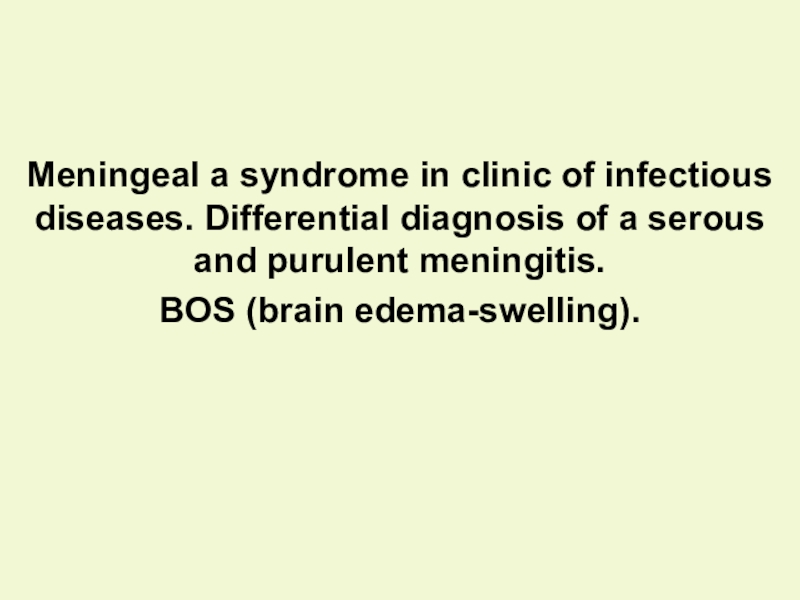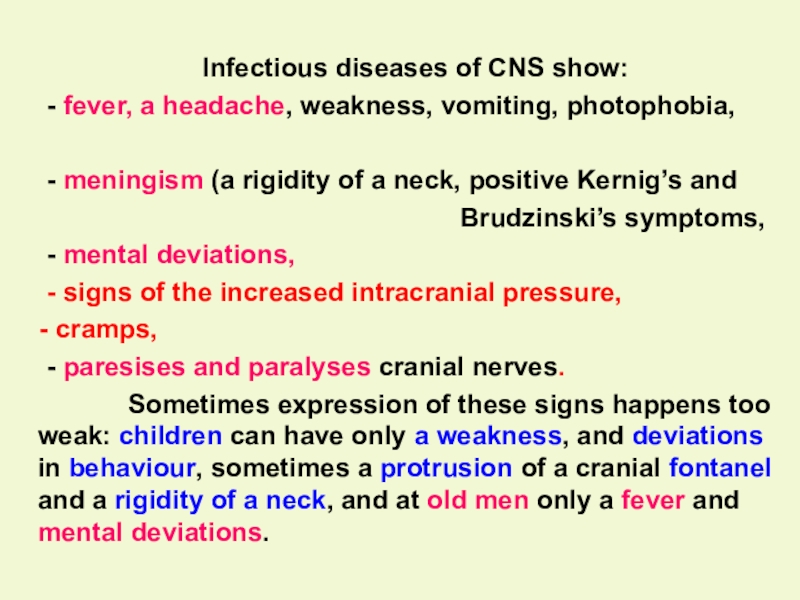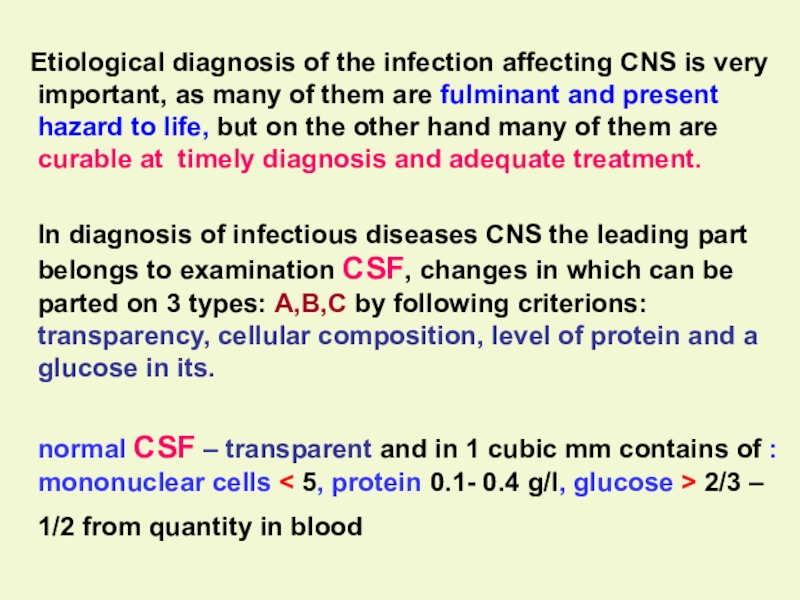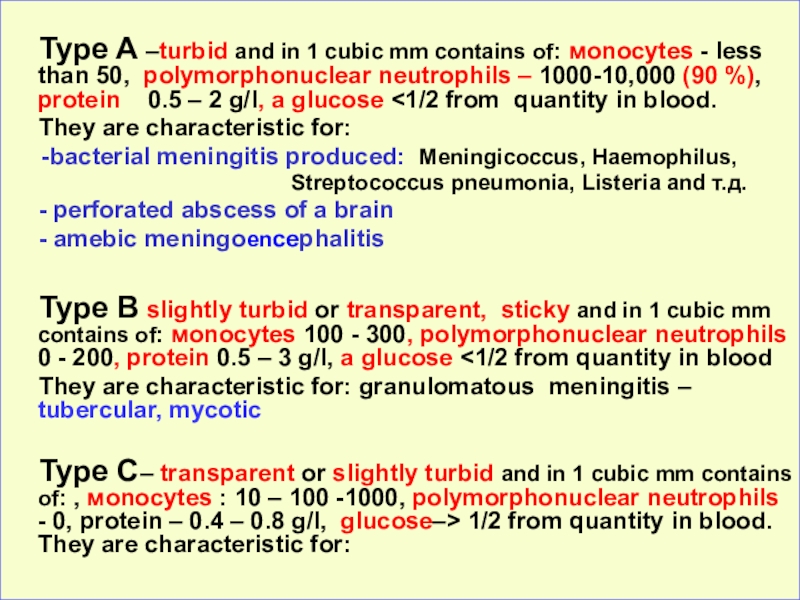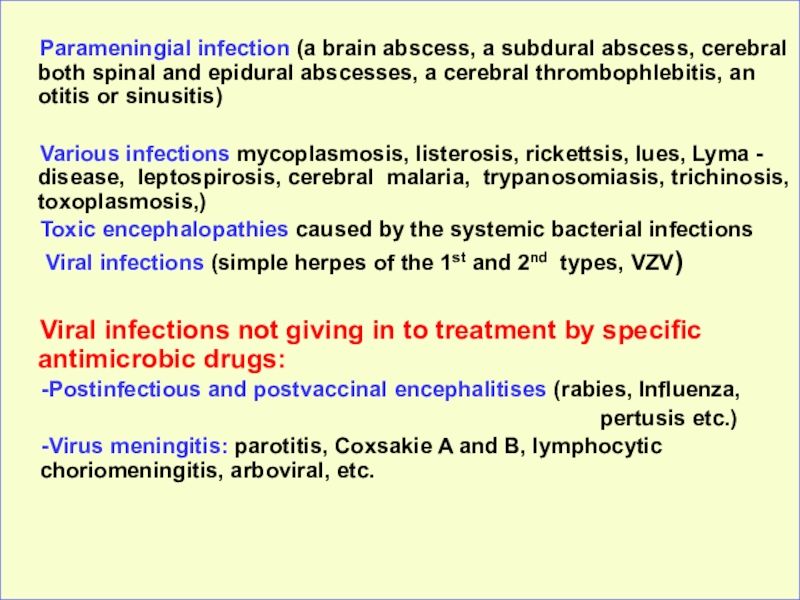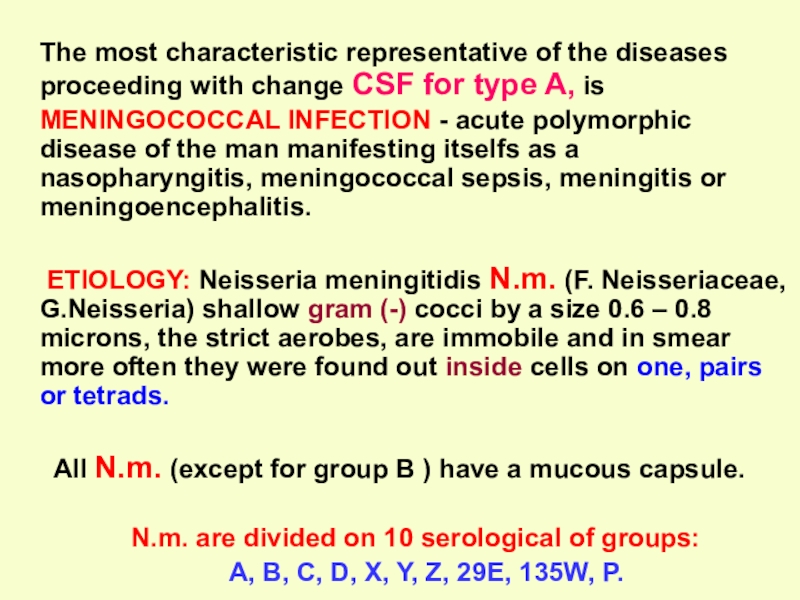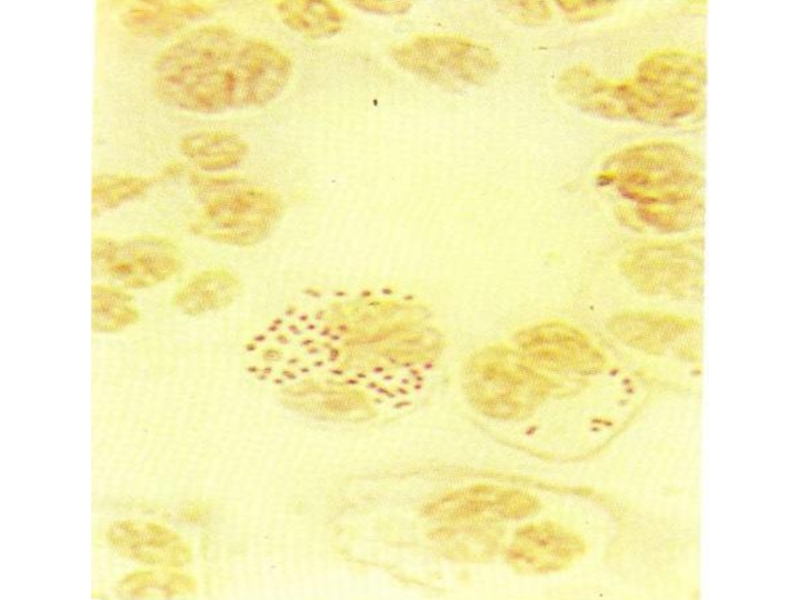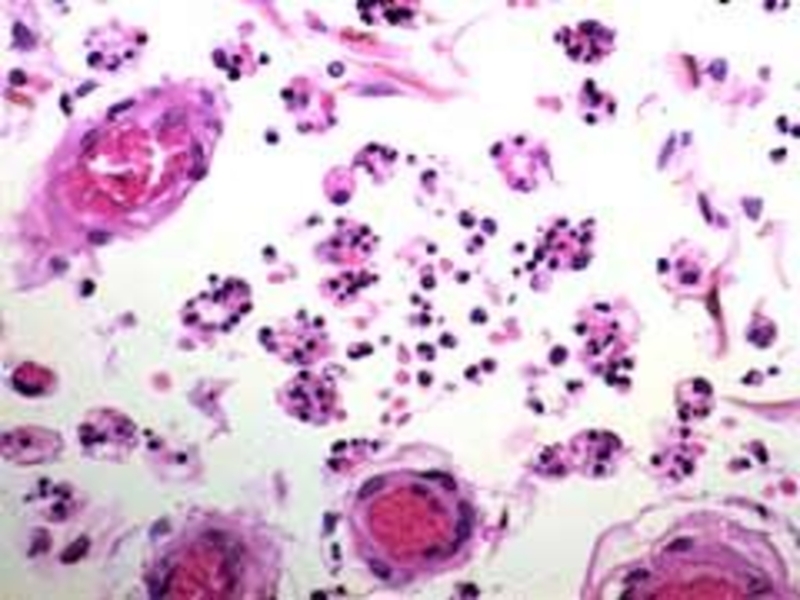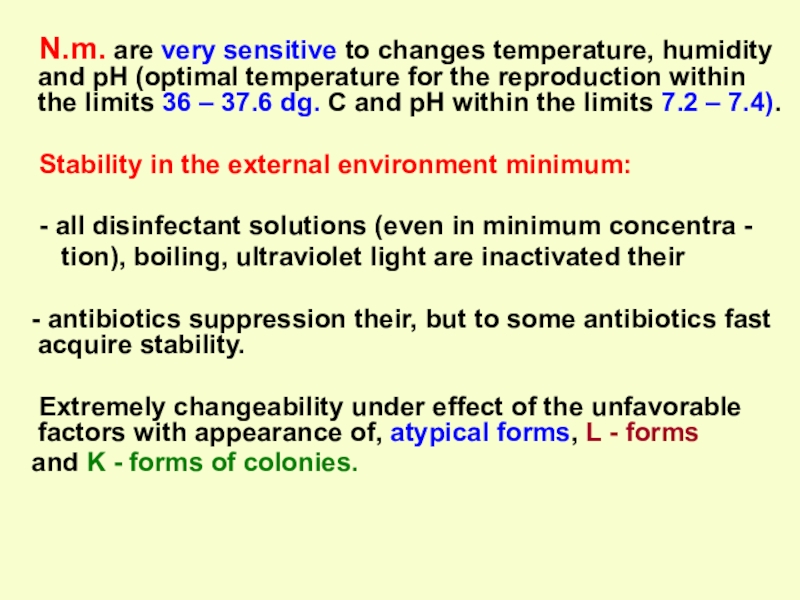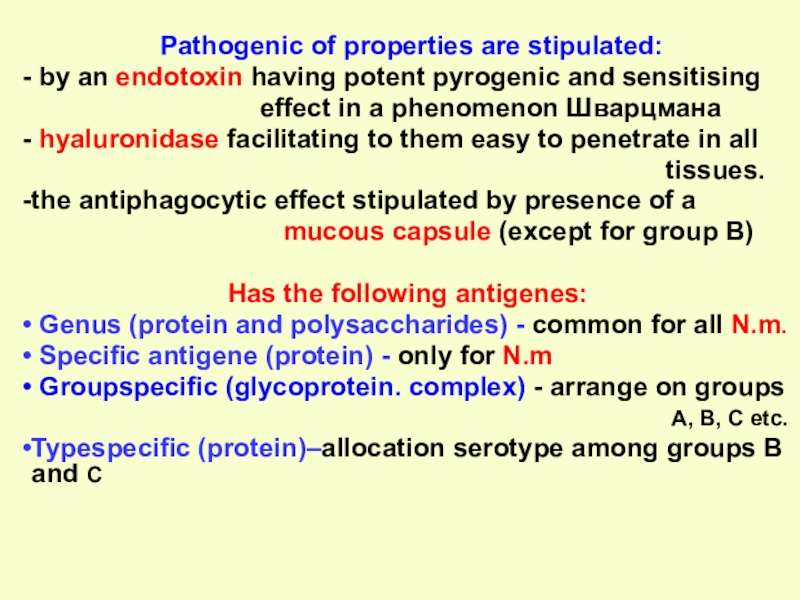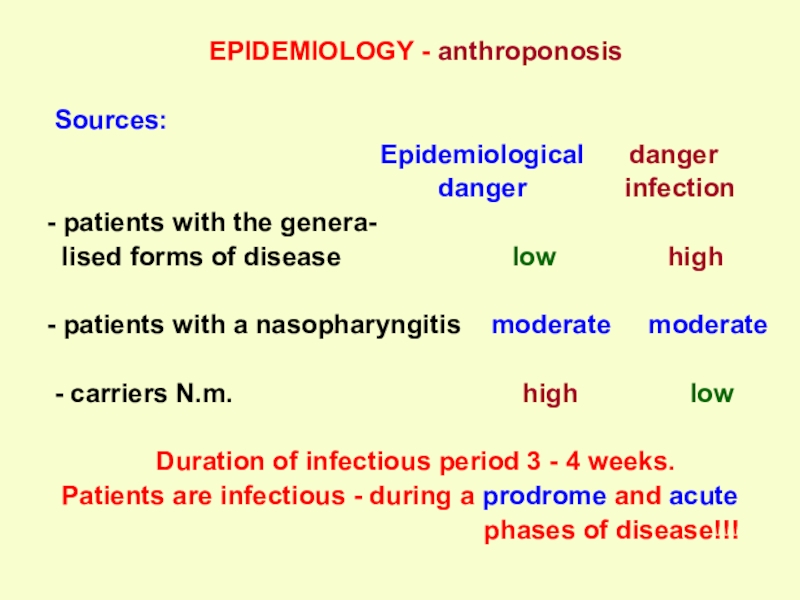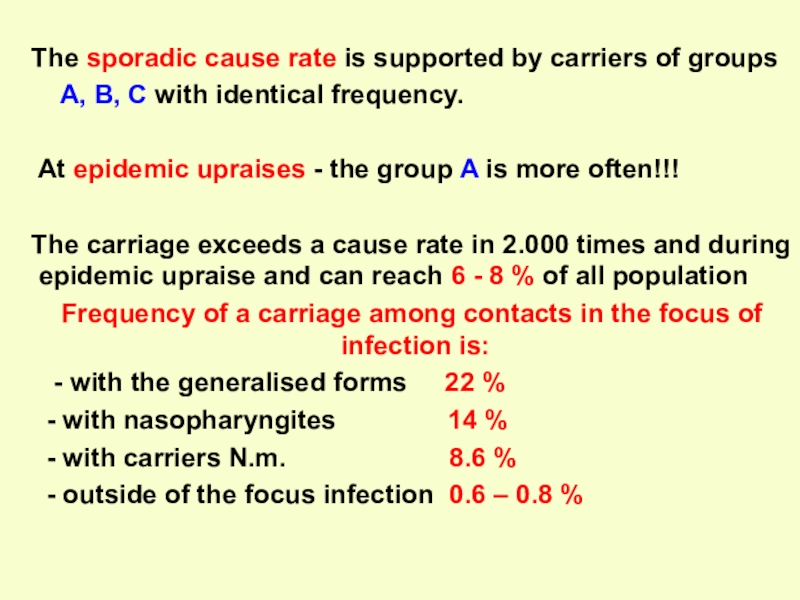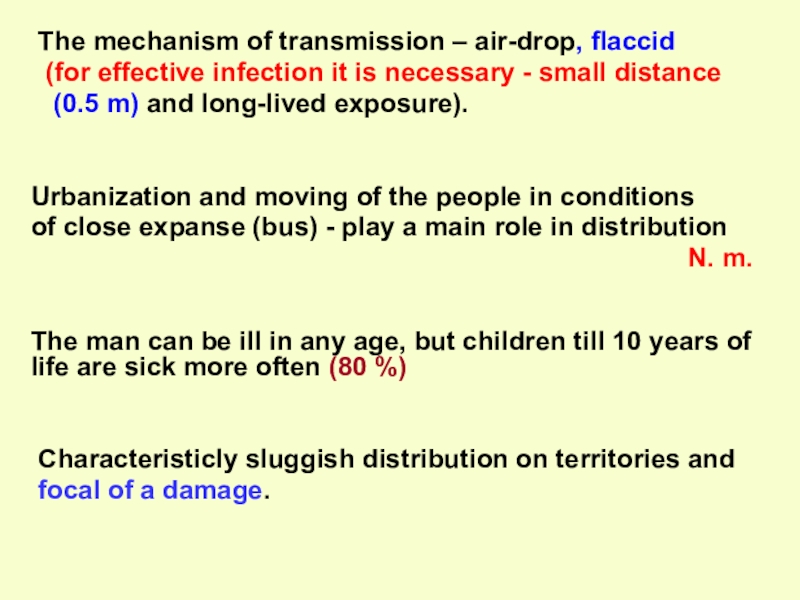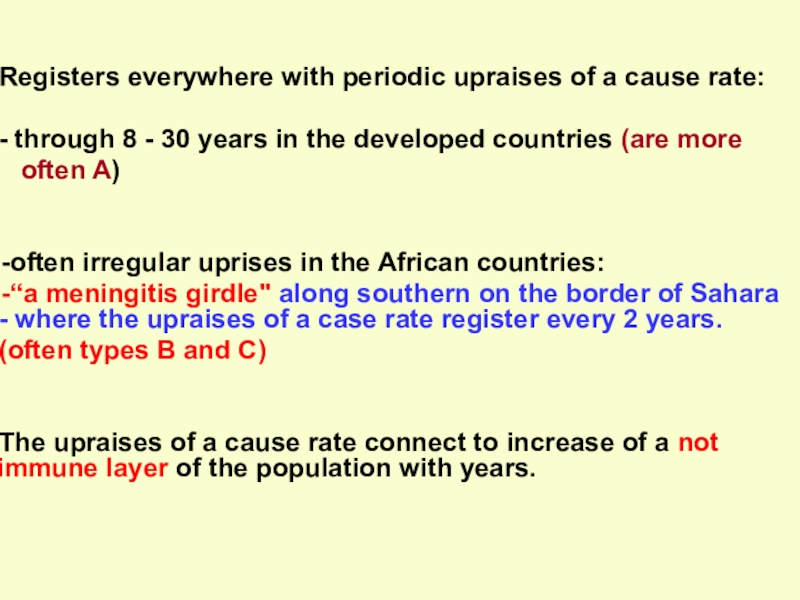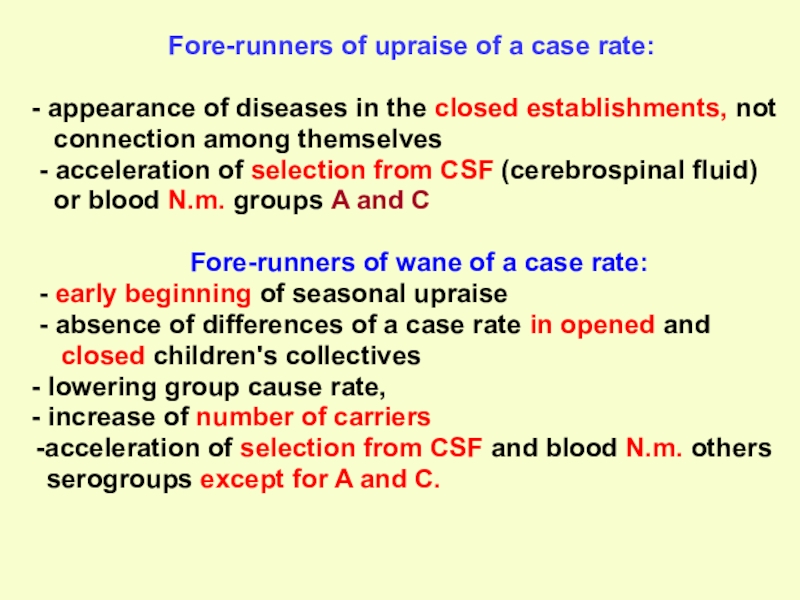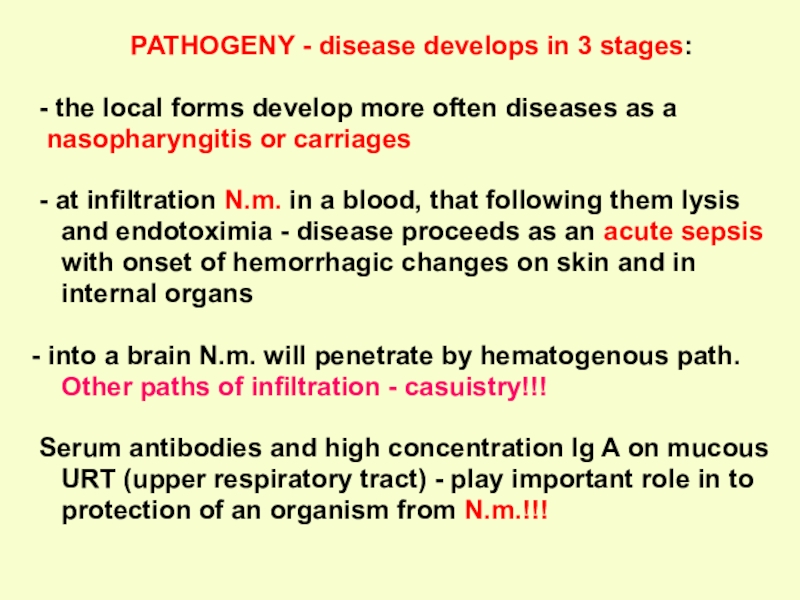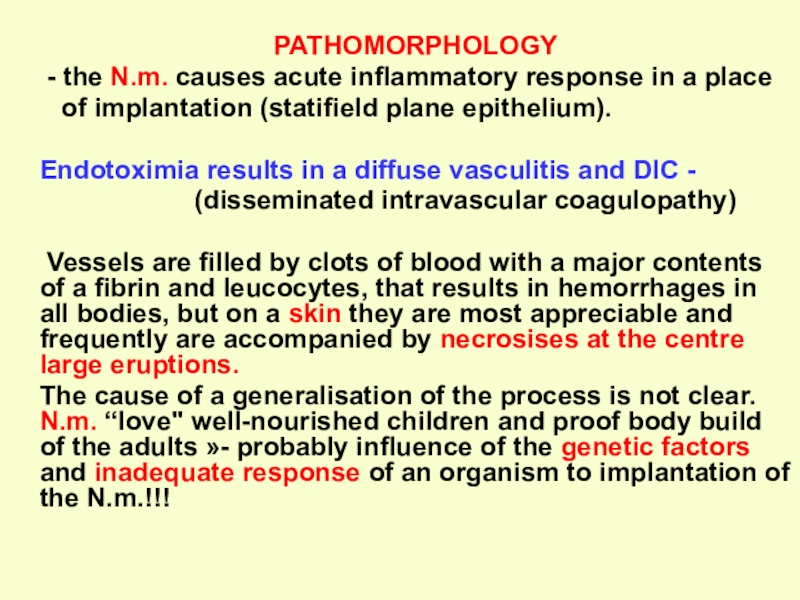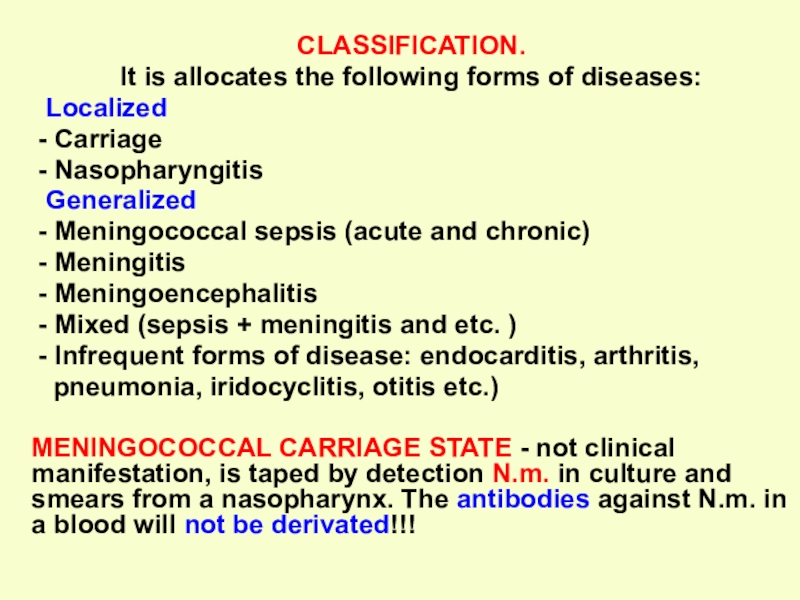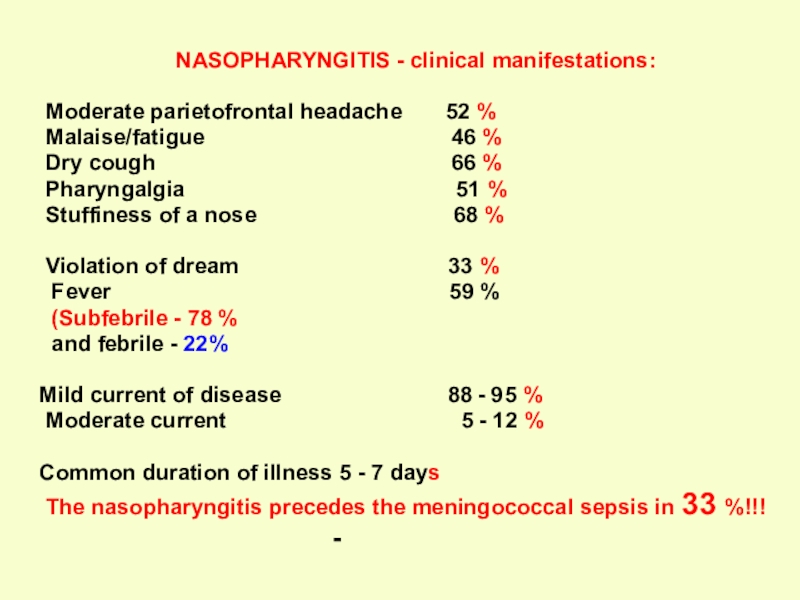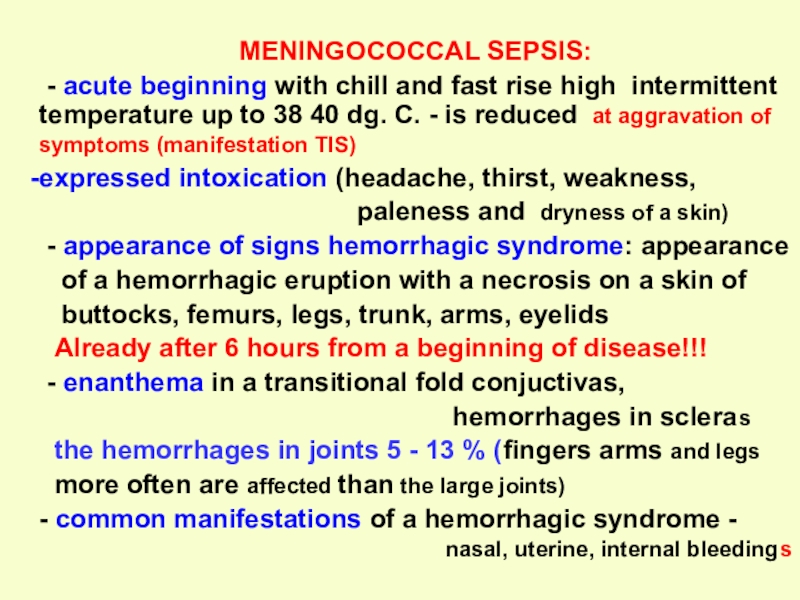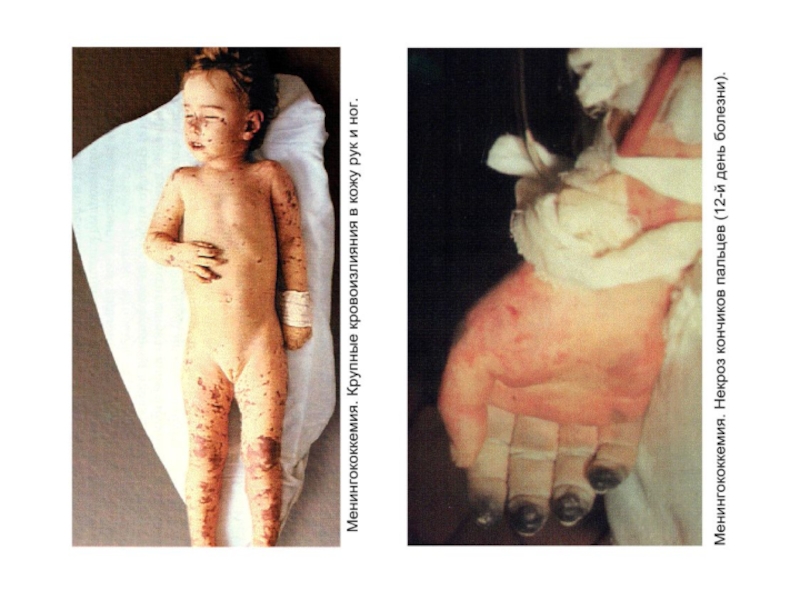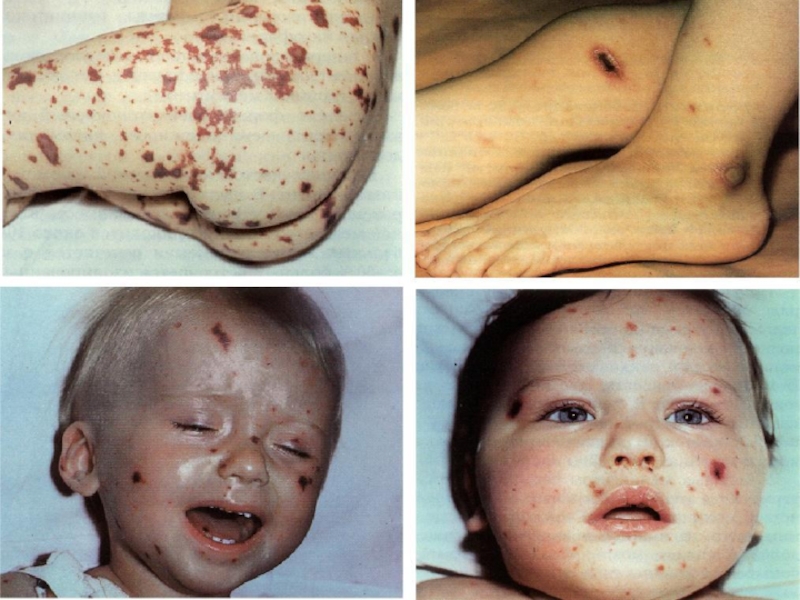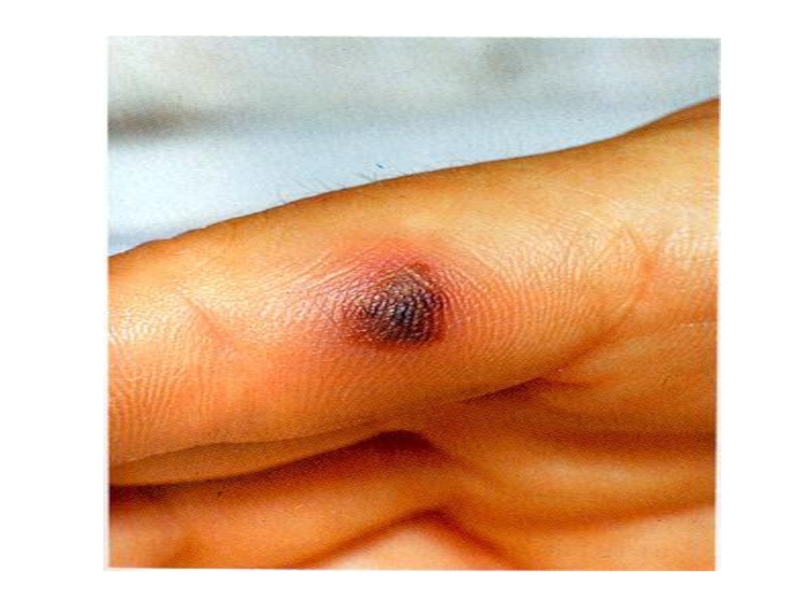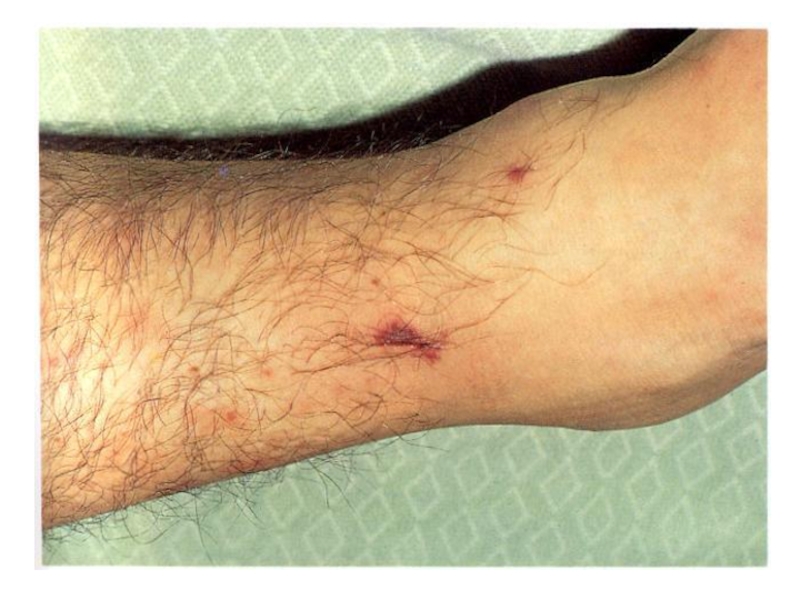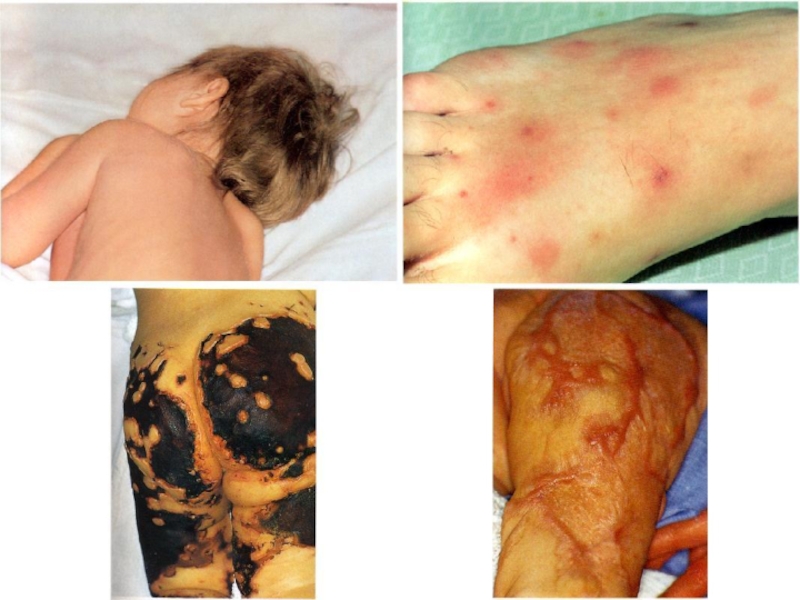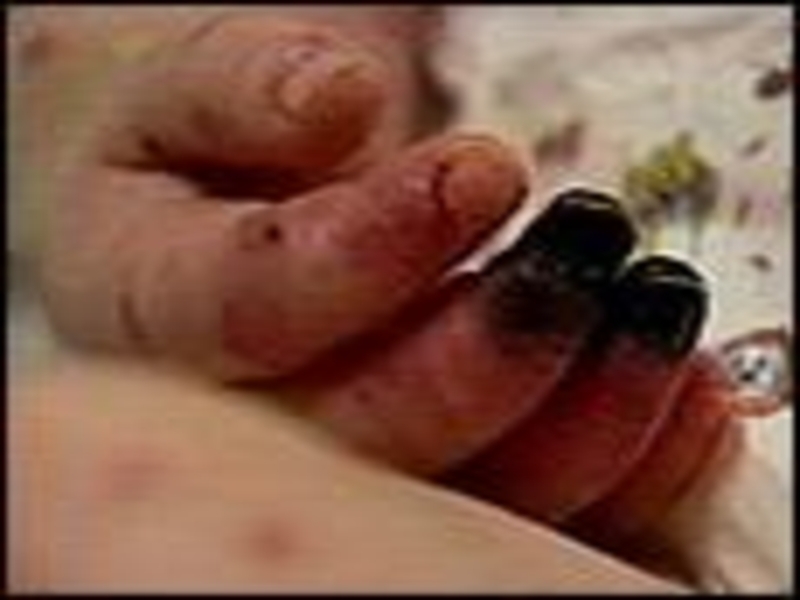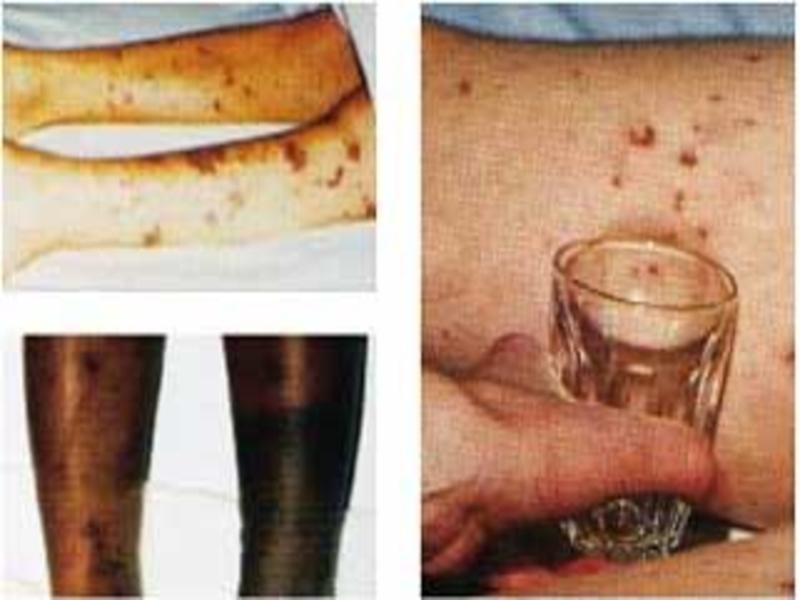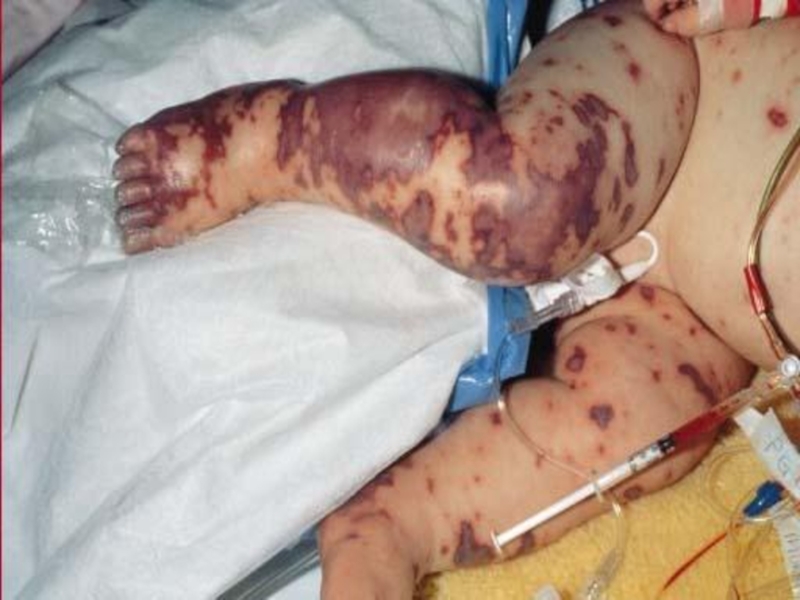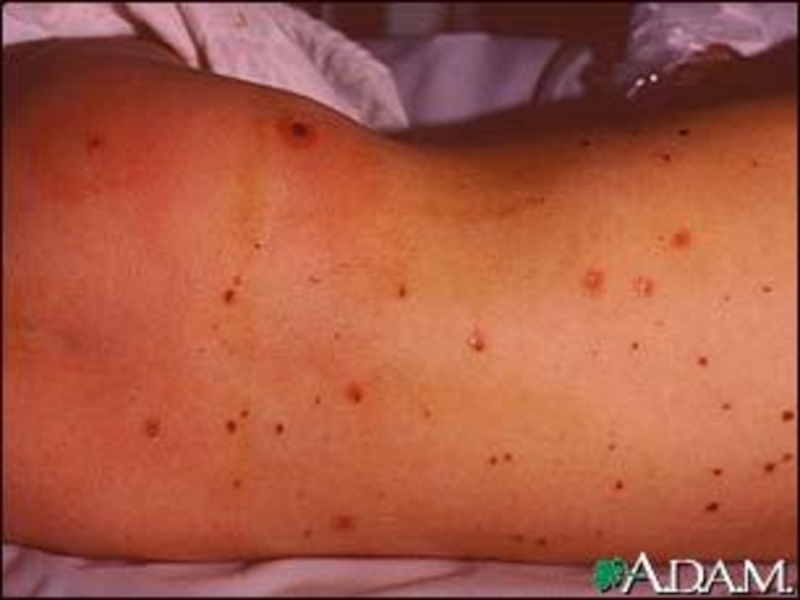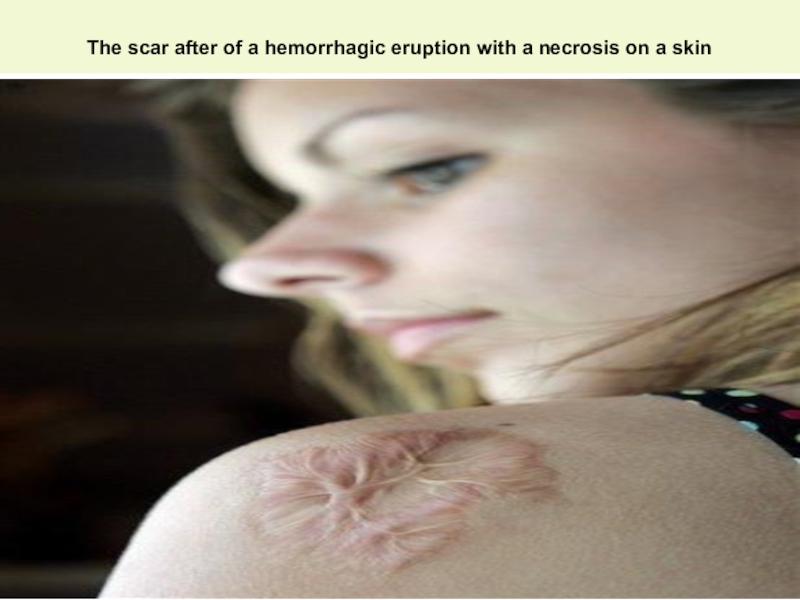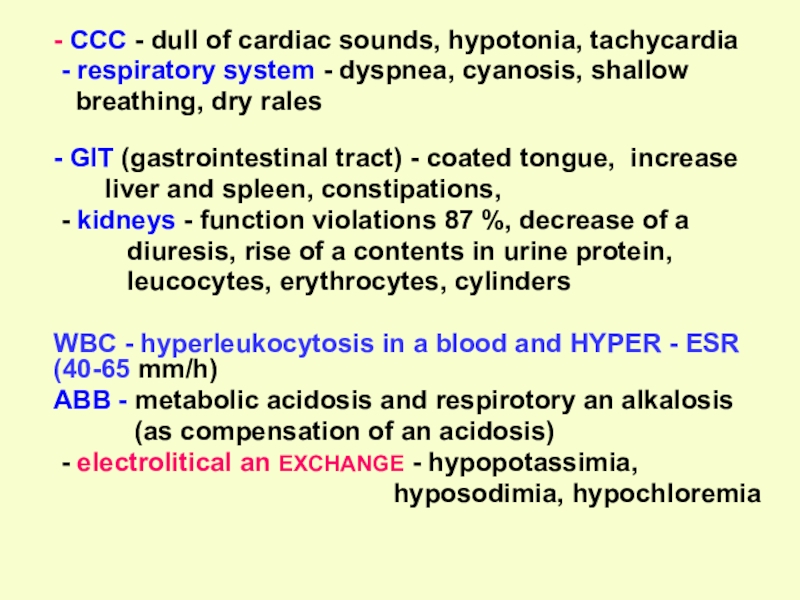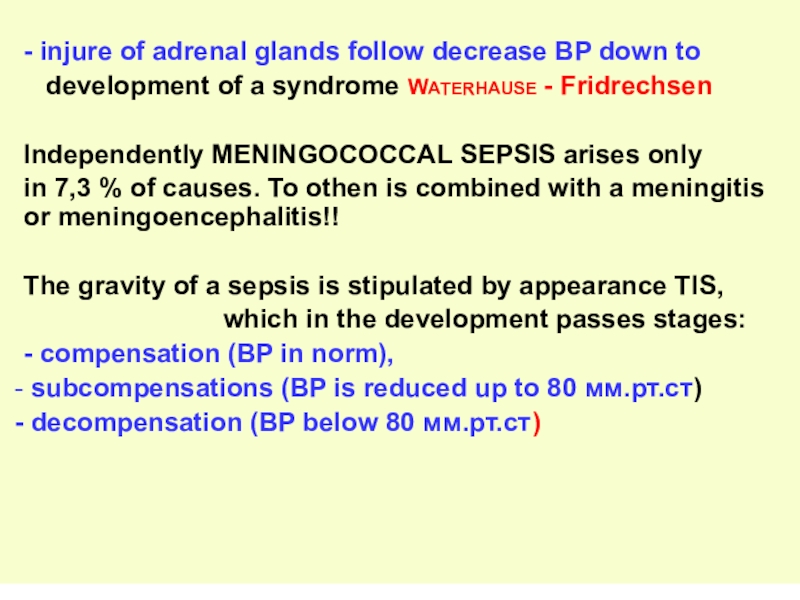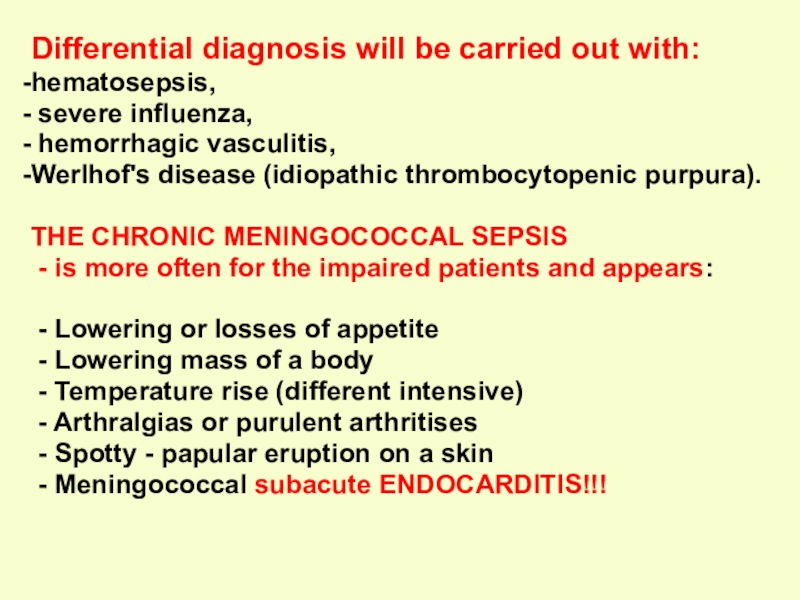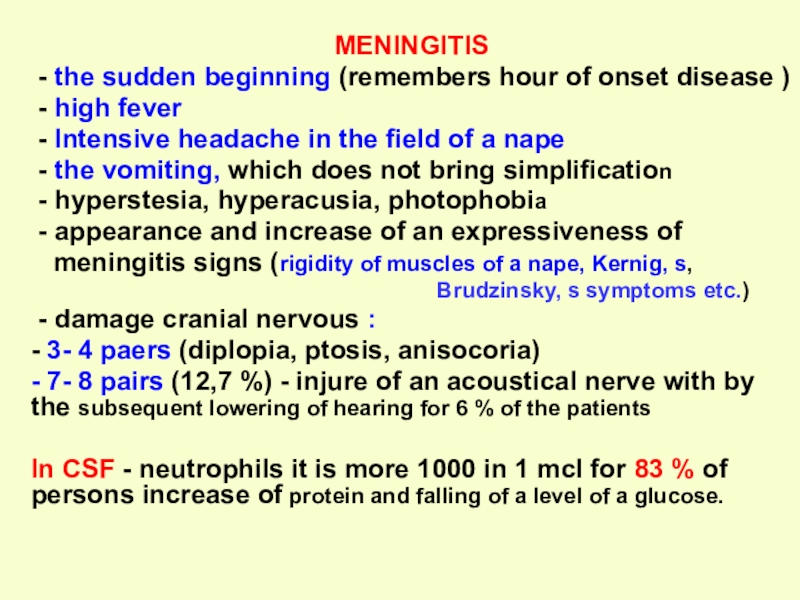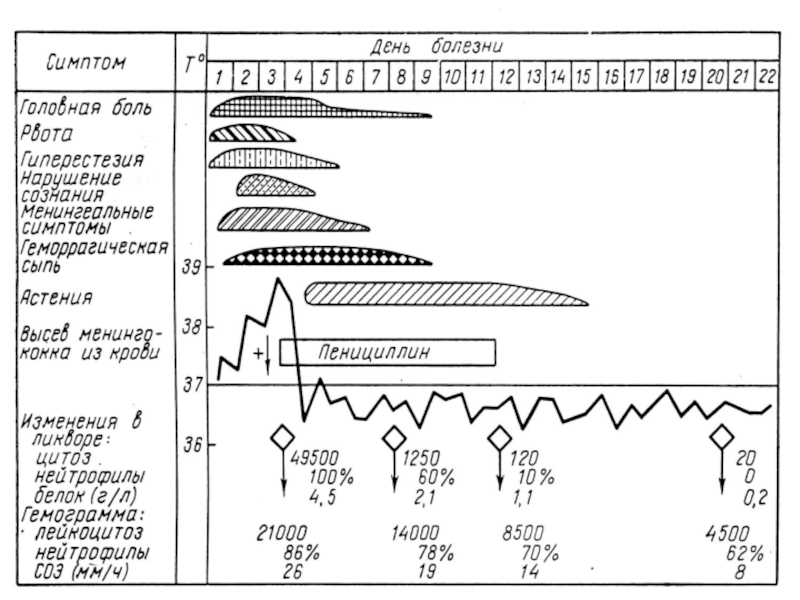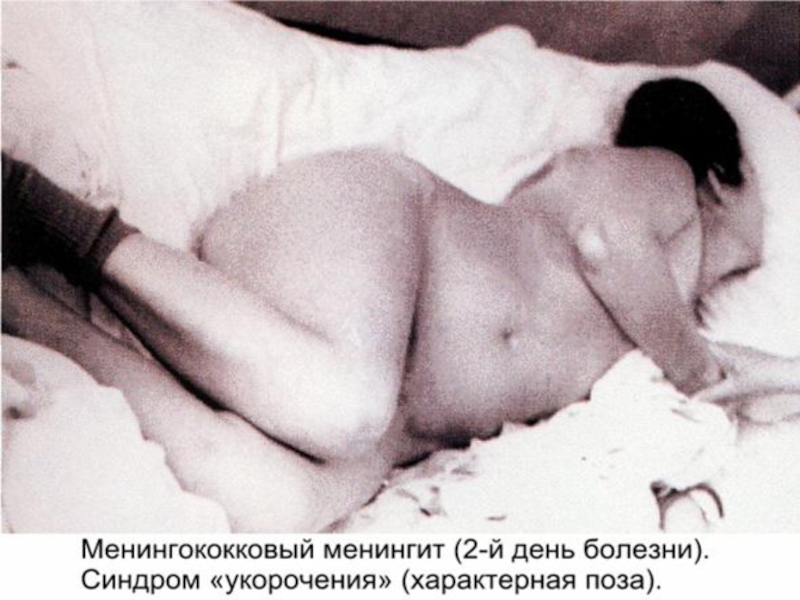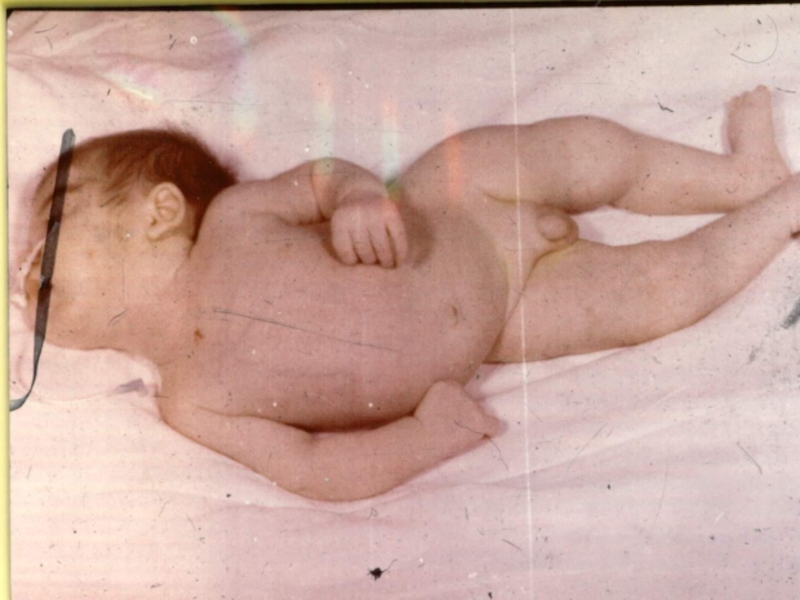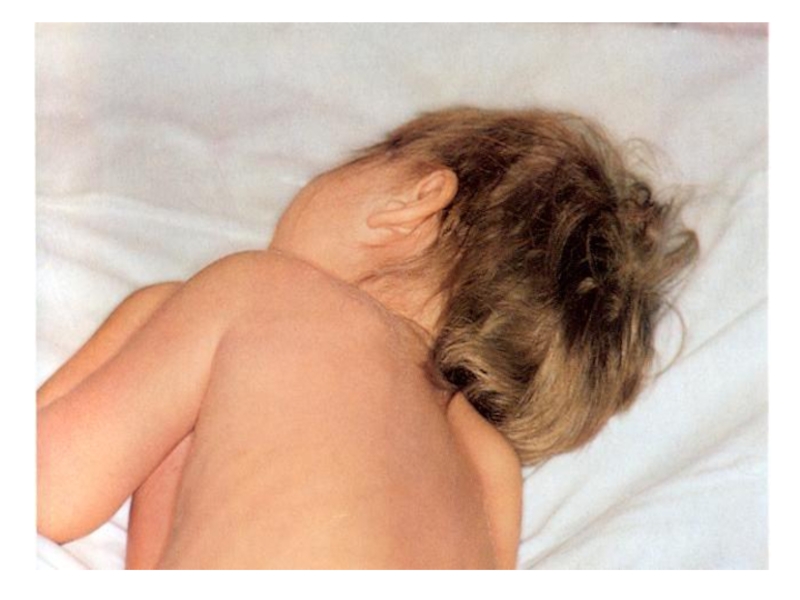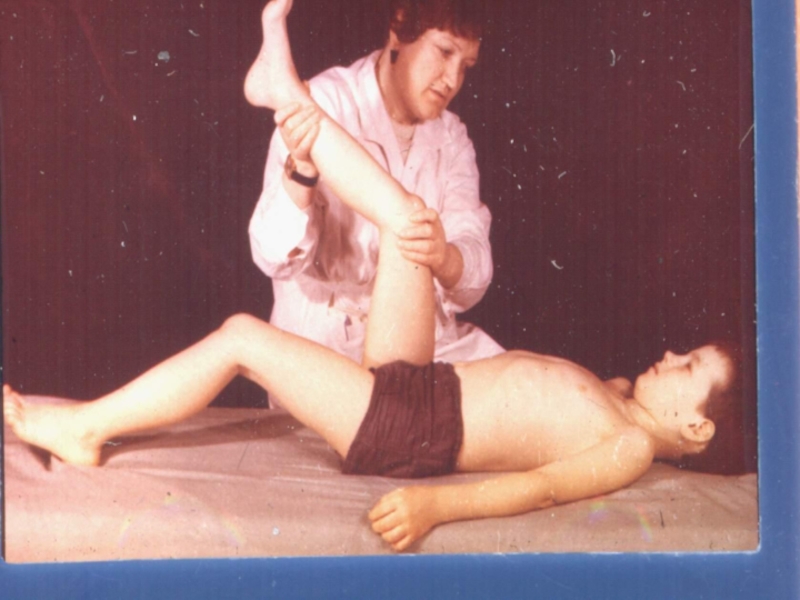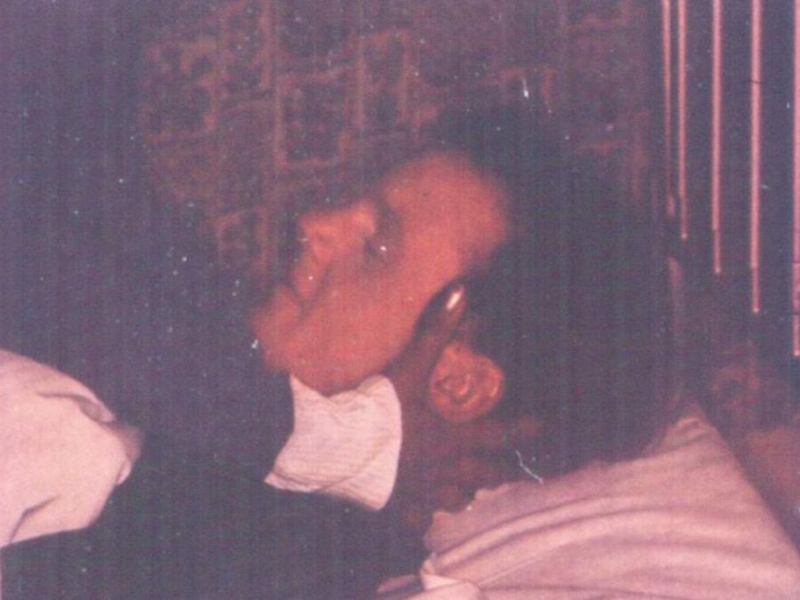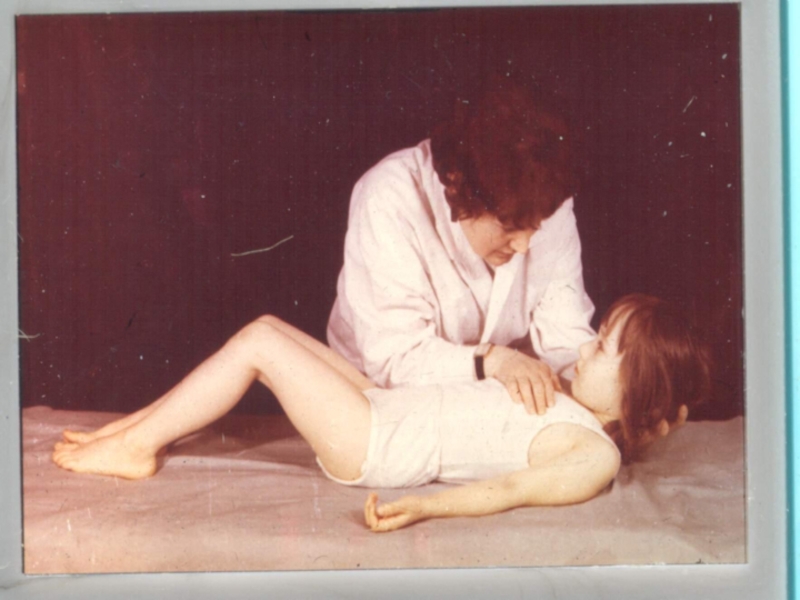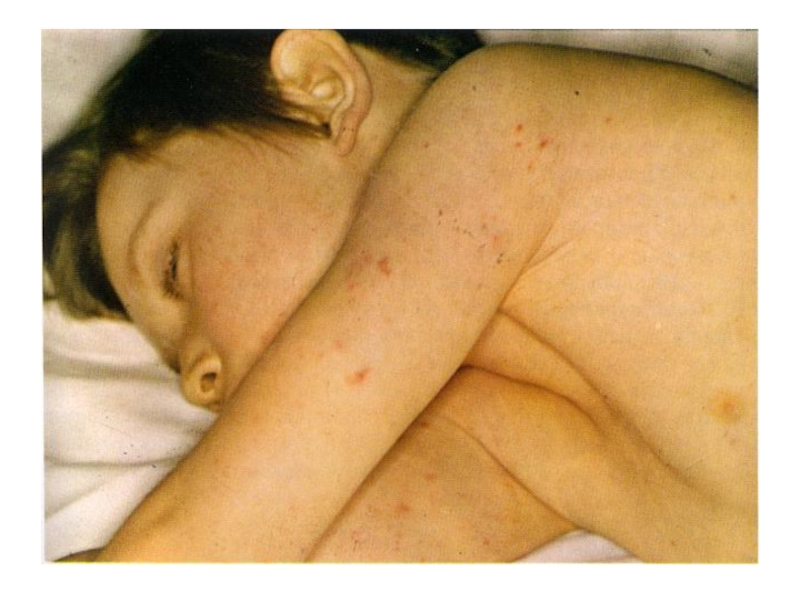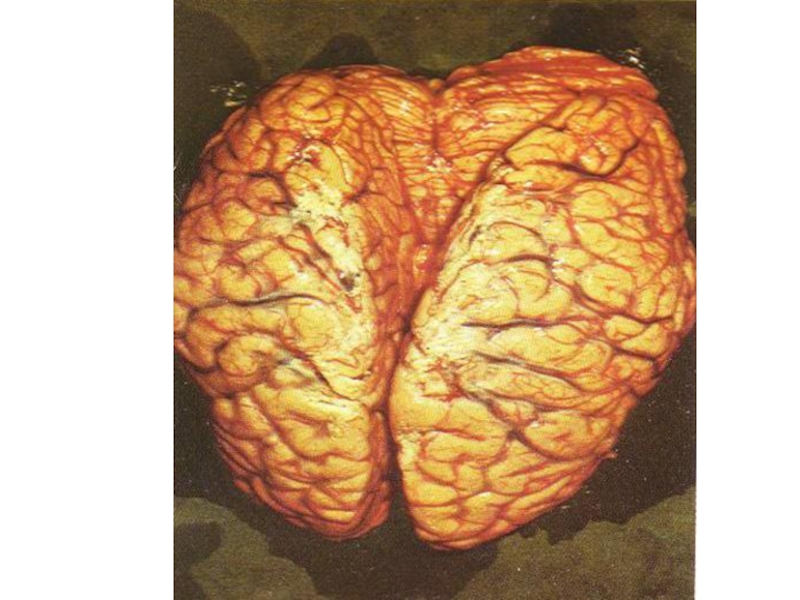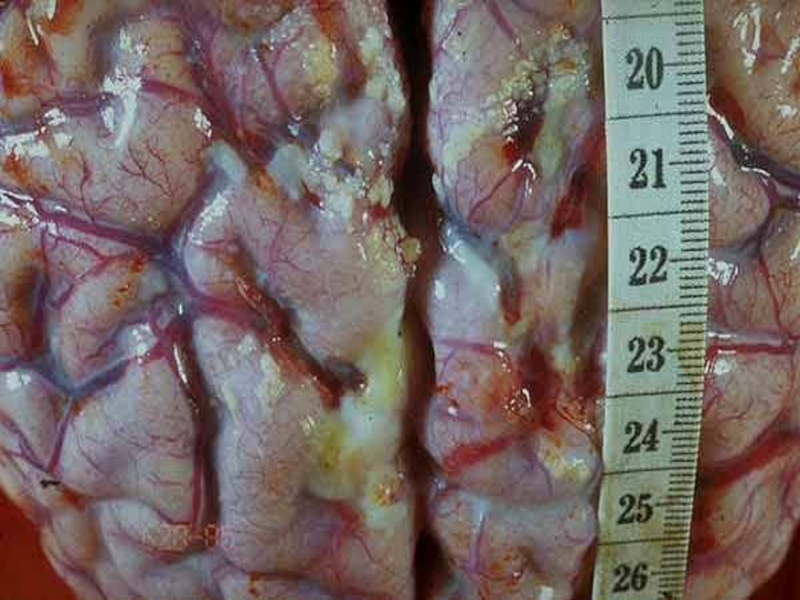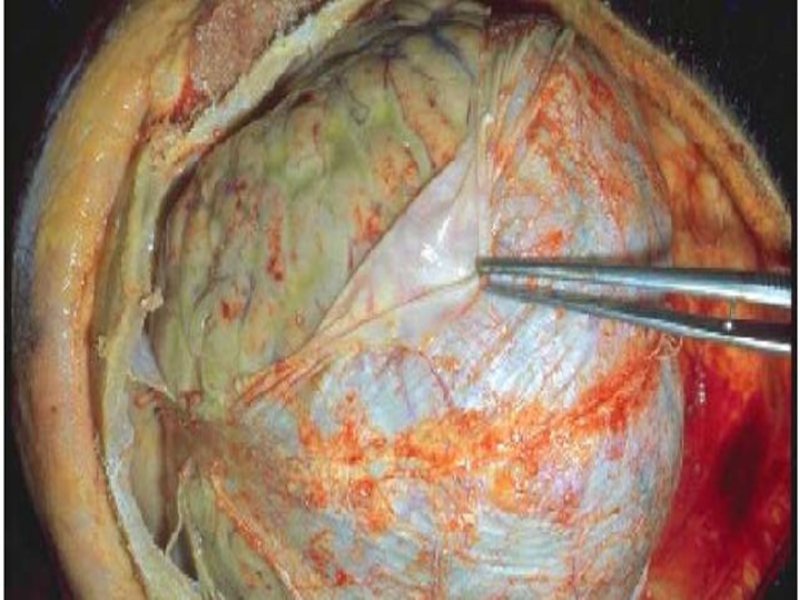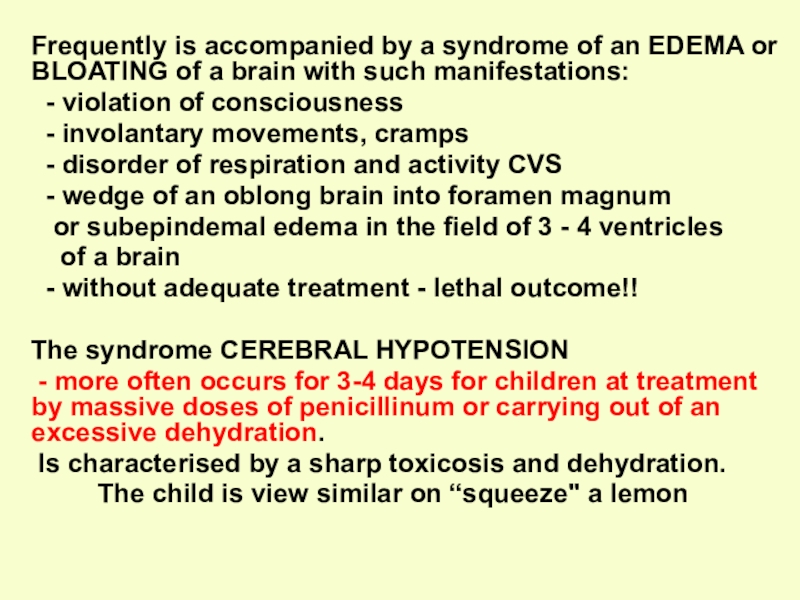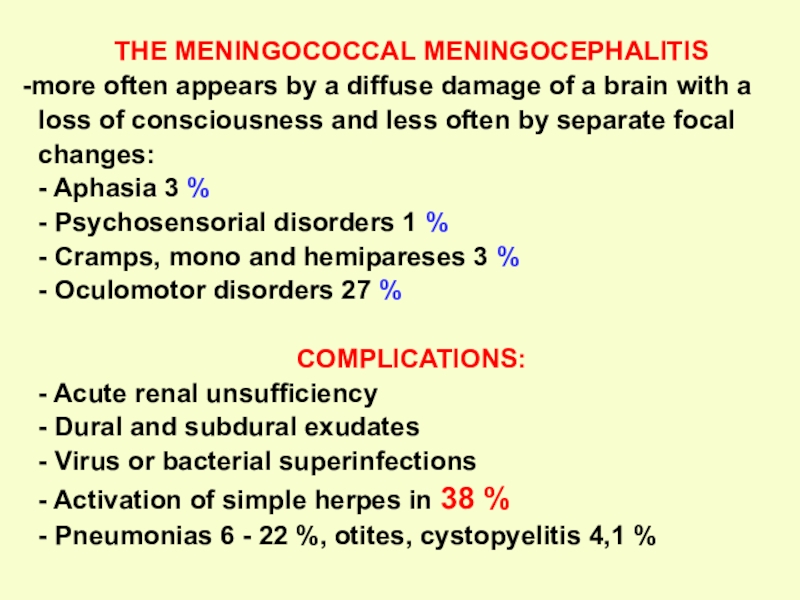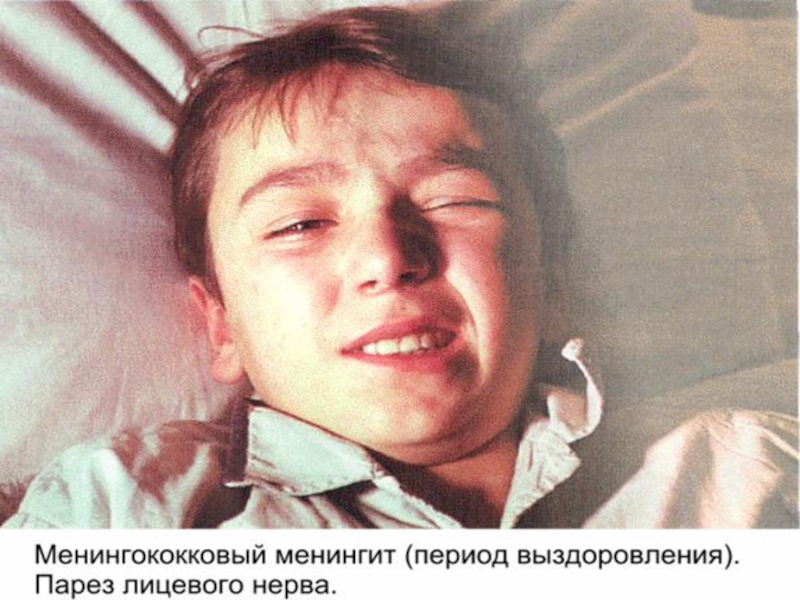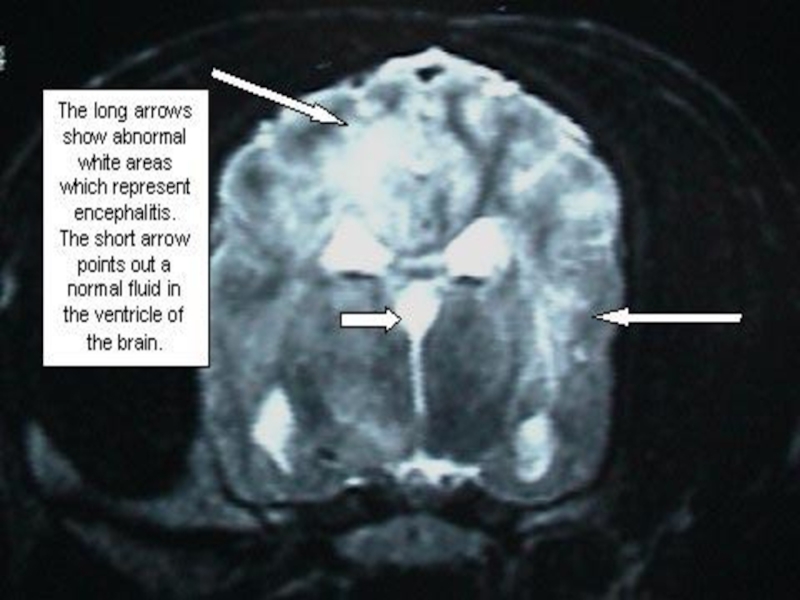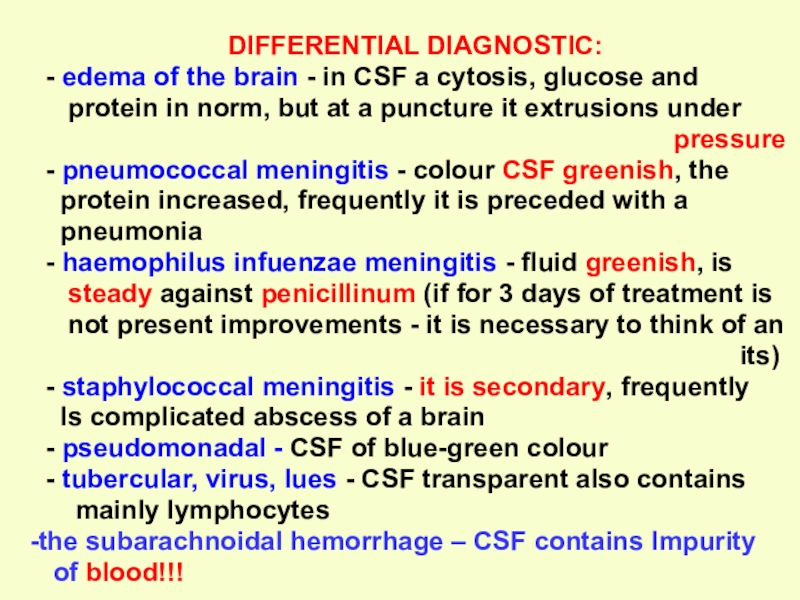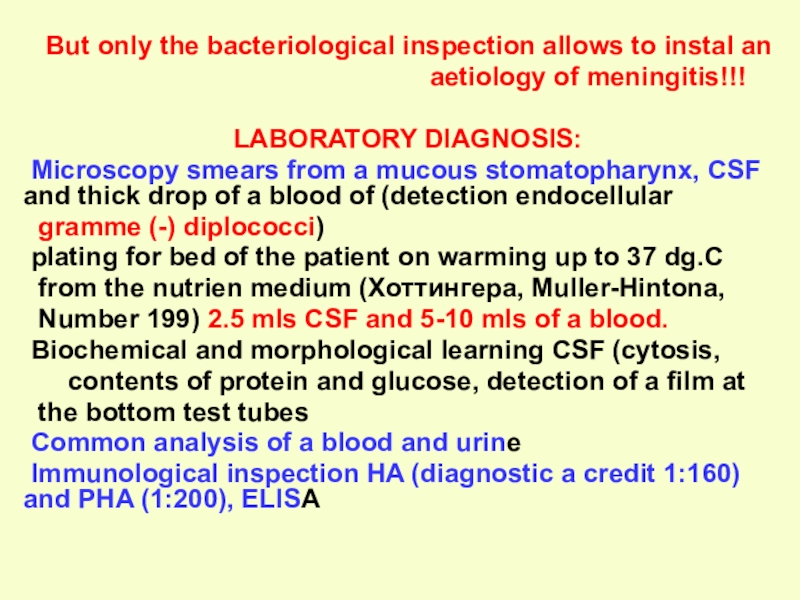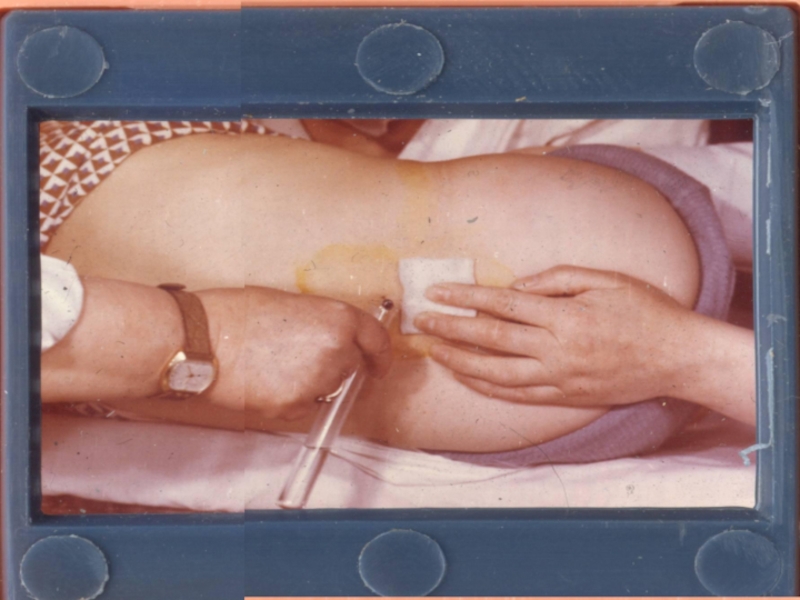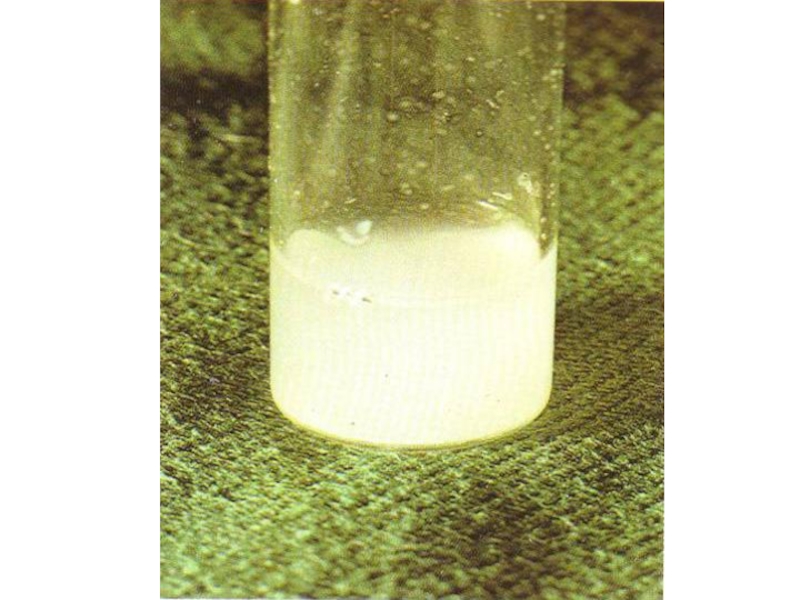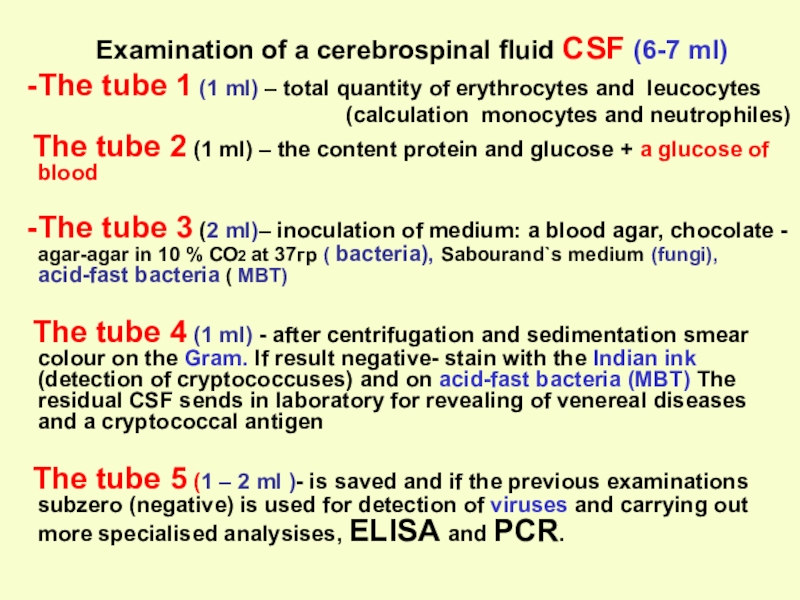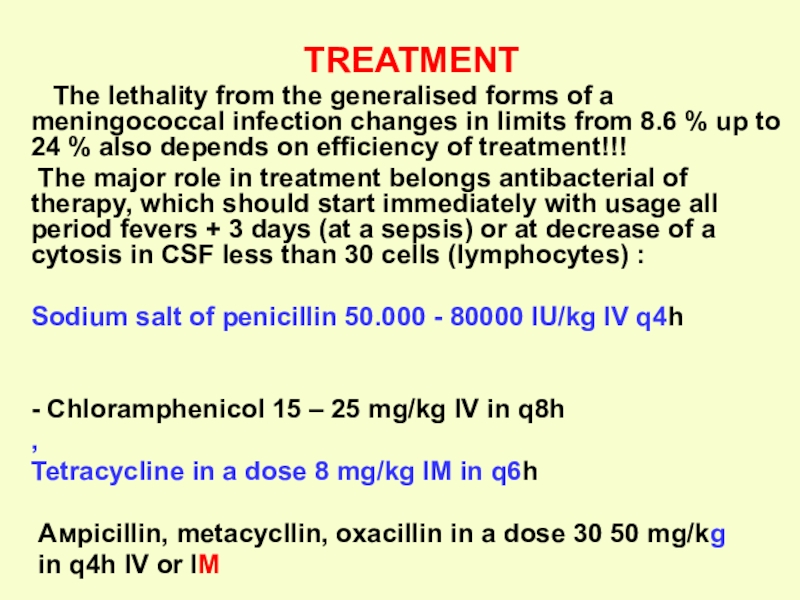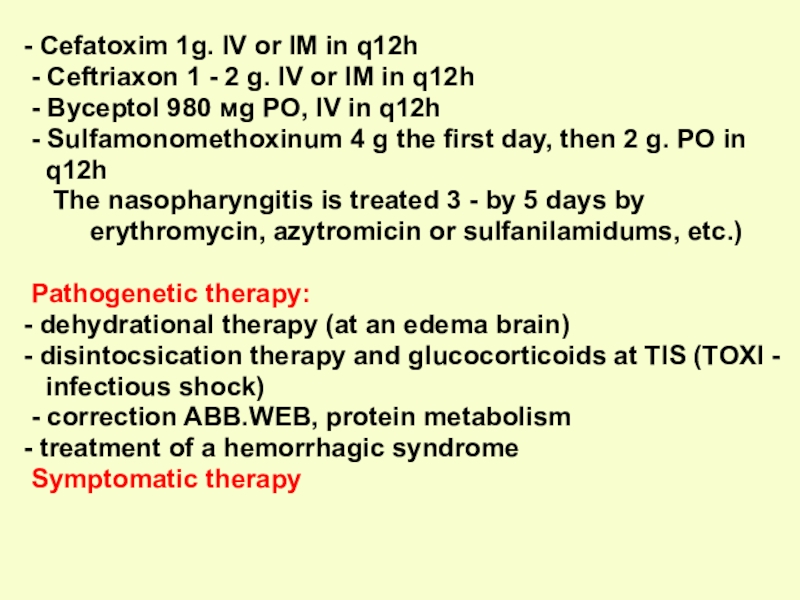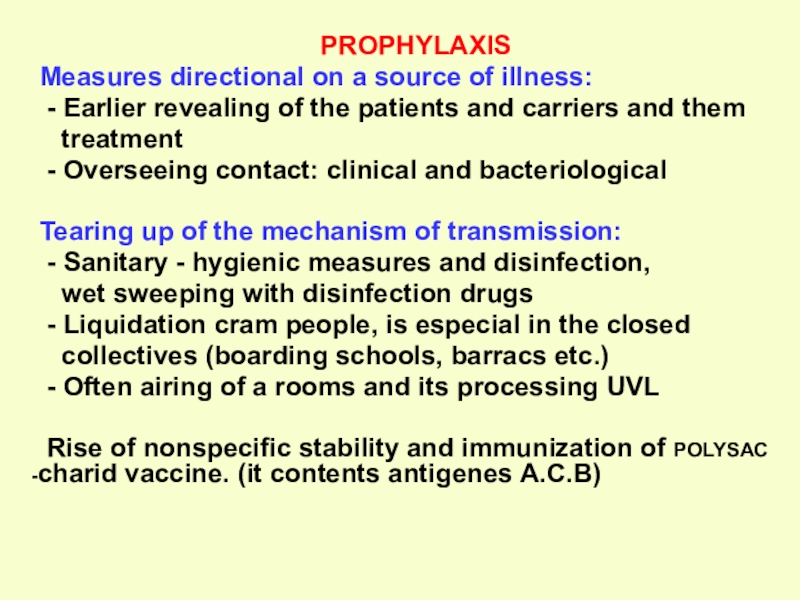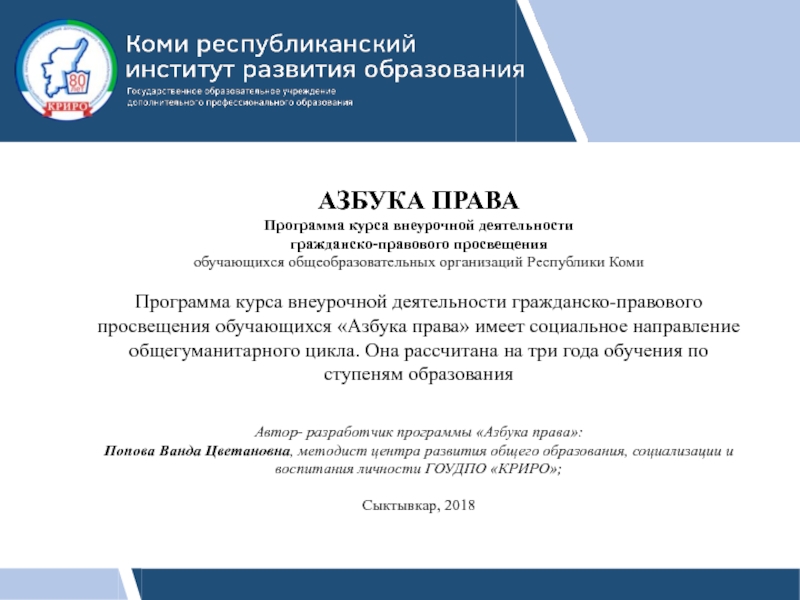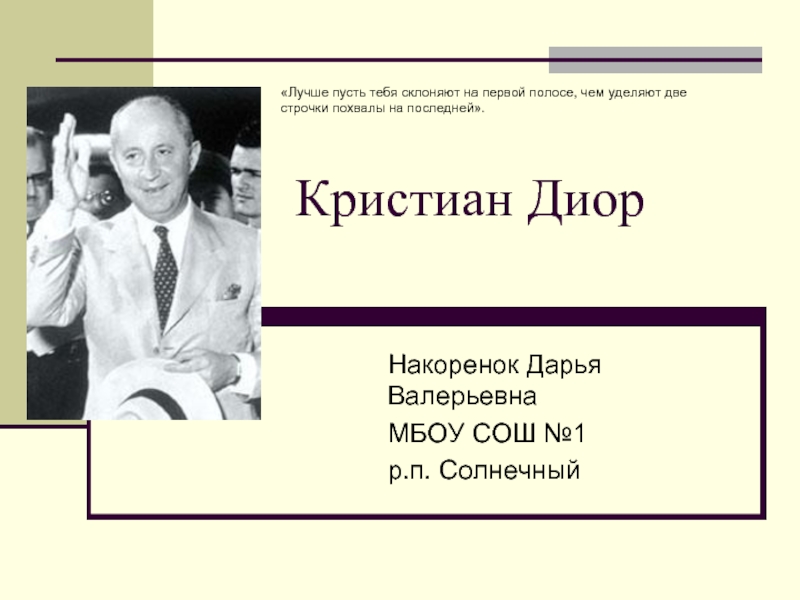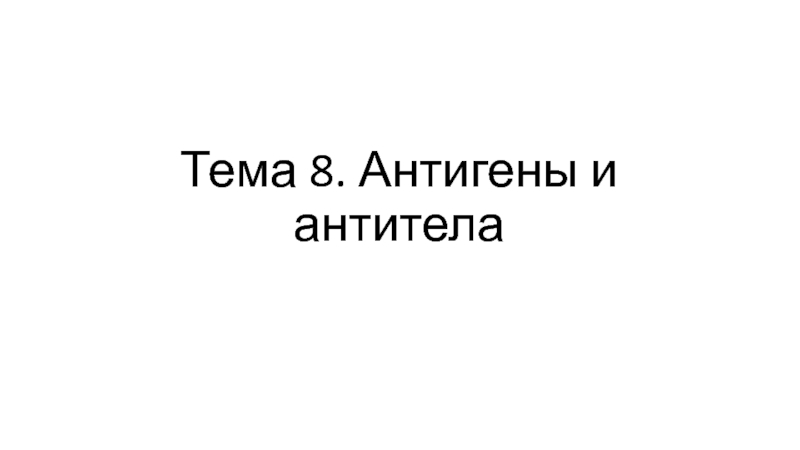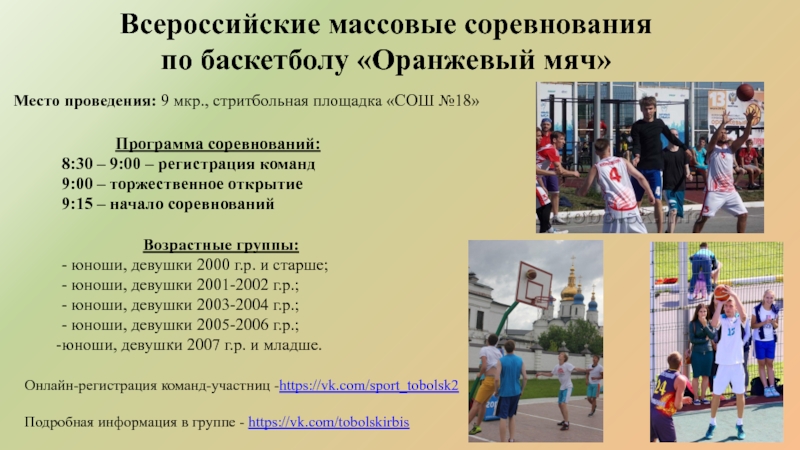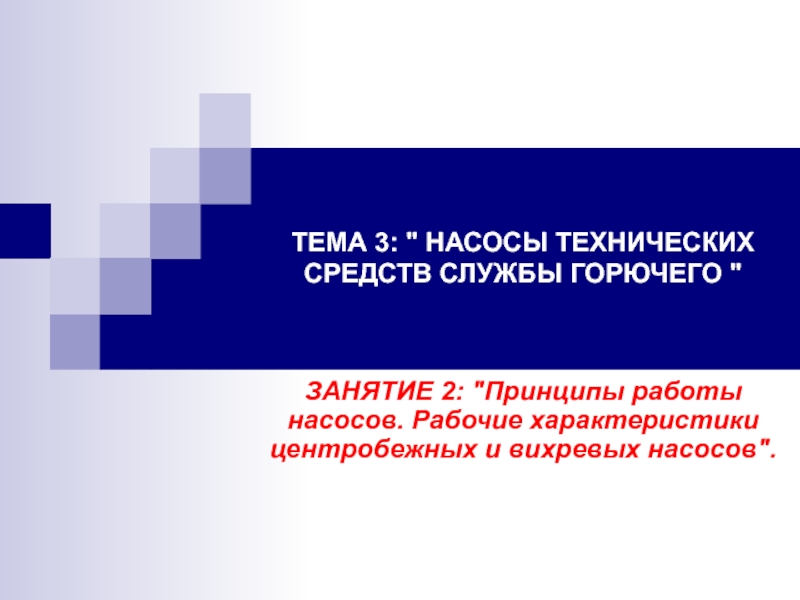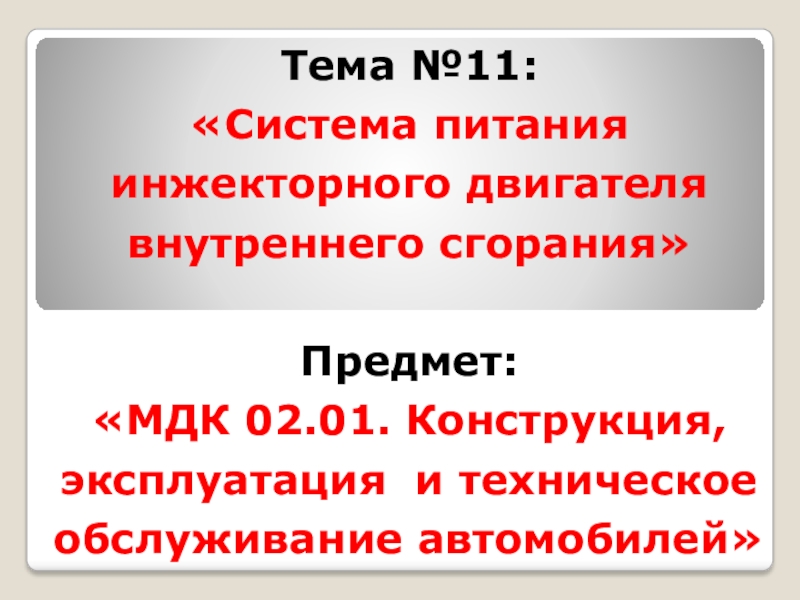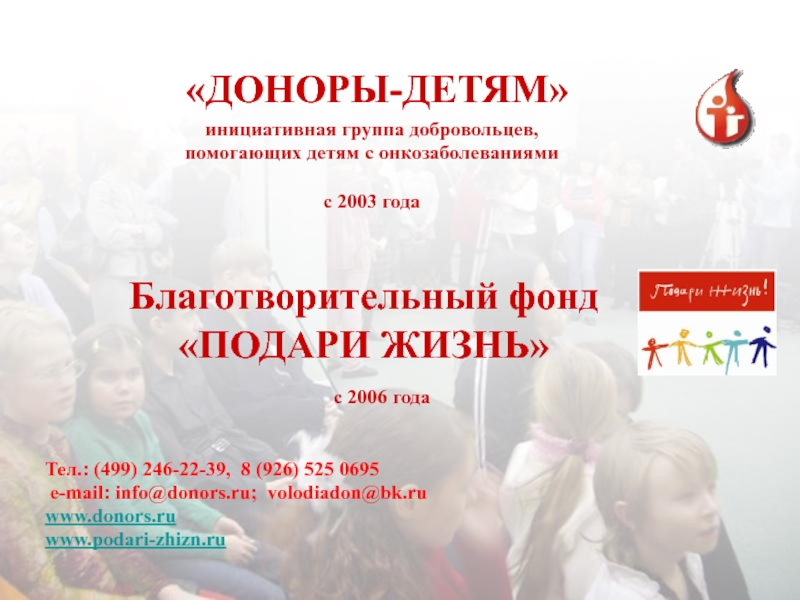Разделы презентаций
- Разное
- Английский язык
- Астрономия
- Алгебра
- Биология
- География
- Геометрия
- Детские презентации
- Информатика
- История
- Литература
- Математика
- Медицина
- Менеджмент
- Музыка
- МХК
- Немецкий язык
- ОБЖ
- Обществознание
- Окружающий мир
- Педагогика
- Русский язык
- Технология
- Физика
- Философия
- Химия
- Шаблоны, картинки для презентаций
- Экология
- Экономика
- Юриспруденция
Мeningeal a syndrome in clinic of infectious diseases. Differential diagnosis
Содержание
- 1. Мeningeal a syndrome in clinic of infectious diseases. Differential diagnosis
- 2. Infectious diseases of CNS show: - fever,
- 3. Etiological diagnosis of the infection affecting
- 4. Type A –turbid and in 1 cubic
- 5. Parameningial infection (a brain abscess, a subdural
- 6. The most characteristic representative of the diseases
- 7. Слайд 7
- 8. Слайд 8
- 9. N.m. are very sensitive to changes
- 10. Pathogenic of properties are stipulated: by
- 11. EPIDEMIOLOGY - anthroponosis Sources:
- 12. The sporadic cause rate is supported by
- 13. The mechanism of transmission – air-drop,
- 14. Registers everywhere with periodic upraises of a
- 15. Fore-runners of upraise of a case rate:-
- 16. PATHOGENY - disease develops in 3 stages:
- 17. PATHOMORPHOLOGY - the N.m. causes acute inflammatory
- 18. CLASSIFICATION. It is allocates the following
- 19. NASOPHARYNGITIS - clinical manifestations: Moderate
- 20. MENINGOCOCCAL SEPSIS: - acute beginning with chill
- 21. Слайд 21
- 22. Слайд 22
- 23. Слайд 23
- 24. Слайд 24
- 25. Слайд 25
- 26. Слайд 26
- 27. Слайд 27
- 28. Слайд 28
- 29. Слайд 29
- 30. Слайд 30
- 31. The scar after of a hemorrhagic eruption with a necrosis on a skin
- 32. - ССС - dull of cardiac sounds,
- 33. - injure of adrenal glands follow decrease
- 34. Differential diagnosis will be carried out with:hematosepsis,
- 35. MENINGITIS - the sudden beginning (remembers hour
- 36. Слайд 36
- 37. Слайд 37
- 38. Слайд 38
- 39. Слайд 39
- 40. Слайд 40
- 41. Слайд 41
- 42. Слайд 42
- 43. Слайд 43
- 44. Слайд 44
- 45. Слайд 45
- 46. Слайд 46
- 47. Frequently is accompanied by a syndrome
- 48. THE MENINGOCOCCAL MENINGOCEPHALITIS more often appears by
- 49. Слайд 49
- 50. Слайд 50
- 51. DIFFERENTIAL DIAGNOSTIC: - edema of the brain
- 52. But only the bacteriological inspection
- 53. Слайд 53
- 54. Слайд 54
- 55. Examination of a cerebrospinal fluid CSF (6-7
- 56. TREATMENT The lethality from the generalised
- 57. - Cefatoxim 1g. IV or IM
- 58. PROPHYLAXISMeasures directional on a source of illness:
- 59. Скачать презентанцию
Infectious diseases of CNS show: - fever, a headache, weakness, vomiting, photophobia,
Слайды и текст этой презентации
Слайд 1
Мeningeal a syndrome in clinic of infectious diseases. Differential diagnosis
of a serous and purulent meningitis.
Слайд 2
Infectious diseases of CNS show:
- fever, a headache,
weakness, vomiting, photophobia,
- meningism (a rigidity of a neck, positive Kernig’s and
Brudzinski’s symptoms,
- mental deviations,
- signs of the increased intracranial pressure,
- cramps,
- paresises and paralyses cranial nerves.
Sometimes expression of these signs happens too weak: children can have only a weakness, and deviations in behaviour, sometimes a protrusion of a cranial fontanel and a rigidity of a neck, and at old men only a fever and mental deviations.
Слайд 3
Etiological diagnosis of the infection affecting CNS is very
important, as many of them are fulminant and present hazard
to life, but on the other hand many of them are curable at timely diagnosis and adequate treatment.In diagnosis of infectious diseases CNS the leading part belongs to examination CSF, changes in which can be parted on 3 types: A,B,C by following criterions: transparency, cellular composition, level of protein and a glucose in its.
normal CSF – transparent and in 1 cubic mm contains of : mononuclear cells < 5, protein 0.1- 0.4 g/l, glucose > 2/3 – 1/2 from quantity in blood
Слайд 4
Type A –turbid and in 1 cubic mm contains of:
мonocytes - less than 50, polymorphonuclear neutrophils – 1000-10,000 (90
%), protein 0.5 – 2 g/l, a glucose <1/2 from quantity in blood.They are characteristic for:
bacterial meningitis produced: Мeningicoccus, Haemophilus,
Streptococcus pneumonia, Listeria and т.д.
- perforated abscess of a brain
- amebic meningoencephalitis
Type B slightly turbid or transparent, sticky and in 1 cubic mm contains of: мonocytes 100 - 300, polymorphonuclear neutrophils 0 - 200, protein 0.5 – 3 g/l, a glucose <1/2 from quantity in blood
They are characteristic for: granulomatous meningitis – tubercular, mycotic
Type C– transparent or slightly turbid and in 1 cubic mm contains of: , мonocytes : 10 – 100 -1000, polymorphonuclear neutrophils - 0, protein – 0.4 – 0.8 g/l, glucose–> 1/2 from quantity in blood. They are characteristic for:
Слайд 5
Parameningial infection (a brain abscess, a subdural abscess, cerebral both
spinal and epidural abscesses, a cerebral thrombophlebitis, an otitis or
sinusitis)Various infections mycoplasmosis, listerosis, rickettsis, lues, Lyma - disease, leptospirosis, cerebral malaria, trypanosomiasis, trichinosis, toxoplasmosis,)
Toxic encephalopathies caused by the systemic bacterial infections
Viral infections (simple herpes of the 1st and 2nd types, VZV)
Viral infections not giving in to treatment by specific antimicrobic drugs:
Postinfectious and postvaccinal encephalitises (rabies, Influenza,
pertusis etc.)
Virus meningitis: parotitis, Coxsakie A and B, lymphocytic choriomeningitis, arboviral, etc.
Слайд 6
The most characteristic representative of the diseases proceeding with change
CSF for type A, is
MENINGOCOCCAL INFECTION - acute polymorphic
disease of the man manifesting itselfs as a nasopharyngitis, meningococcal sepsis, meningitis or meningoencephalitis.ETIOLOGY: Neisseria meningitidis N.m. (F. Neisseriaceae, G.Neisseria) shallow gram (-) cocci by a size 0.6 – 0.8 microns, the strict aerobes, are immobile and in smear more often they were found out inside cells on one, pairs or tetrads.
All N.m. (except for group B ) have a mucous capsule.
N.m. are divided on 10 serological of groups:
A, B, C, D, X, Y, Z, 29E, 135W, P.
Слайд 9
N.m. are very sensitive to changes temperature, humidity and
рН (optimal temperature for the reproduction within the limits 36
– 37.6 dg. C and рН within the limits 7.2 – 7.4).Stability in the external environment minimum:
- all disinfectant solutions (even in minimum concentra -
tion), boiling, ultraviolet light are inactivated their
- antibiotics suppression their, but to some antibiotics fast acquire stability.
Extremely changeability under effect of the unfavorable factors with appearance of, atypical forms, L - forms
and K - forms of colonies.
Слайд 10
Pathogenic of properties are stipulated:
by an endotoxin
having potent pyrogenic and sensitising
effect in a phenomenon Шварцмана hyaluronidase facilitating to them easy to penetrate in all
tissues.
the antiphagocytic effect stipulated by presence of a
mucous capsule (except for group B)
Has the following antigenes:
Genus (protein and polysaccharides) - common for all N.m.
Specific antigene (protein) - only for N.m
Groupspecific (glycoprotein. complex) - arrange on groups
A, B, C etc.
Typespecific (protein)–allocation serotype among groups B and C
Слайд 11
EPIDEMIOLOGY - anthroponosis
Sources:
Epidemiological danger
danger infection
- patients with the genera-
lised forms of disease low high
- patients with a nasopharyngitis moderate moderate
- carriers N.m. high low
Duration of infectious period 3 - 4 weeks.
Patients are infectious - during a prodrome and acute
phases of disease!!!
Слайд 12
The sporadic cause rate is supported by carriers of groups
A, B, C with identical frequency.
At epidemic upraises - the group A is more often!!!The carriage exceeds a cause rate in 2.000 times and during epidemic upraise and can reach 6 - 8 % of all population
Frequency of a carriage among contacts in the focus of infection is:
- with the generalised forms 22 %
- with nasopharyngites 14 %
- with carriers N.m. 8.6 %
- outside of the focus infection 0.6 – 0.8 %
Слайд 13
The mechanism of transmission – air-drop, flaccid
(for effective
infection it is necessary - small distance
(0.5 m) and long-lived exposure).Urbanization and moving of the people in conditions
of close expanse (bus) - play a main role in distribution
N. m.
The man can be ill in any age, but children till 10 years of life are sick more often (80 %)
Characteristicly sluggish distribution on territories and
focal of a damage.
Слайд 14
Registers everywhere with periodic upraises of a cause rate:
-
through 8 - 30 years in the developed countries (are
moreoften A)
often irregular uprises in the African countries:
“a meningitis girdle" along southern on the border of Sahara - where the upraises of a case rate register every 2 years.
(often types B and C)
The upraises of a cause rate connect to increase of a not immune layer of the population with years.
Слайд 15
Fore-runners of upraise of a case rate:
- appearance of diseases
in the closed establishments, not
connection among themselves
- acceleration of selection from СSF (cerebrospinal fluid) or blood N.m. groups A and C
Fore-runners of wane of a case rate:
- early beginning of seasonal upraise
- absence of differences of a case rate in opened and
closed children's collectives
- lowering group cause rate,
- increase of number of carriers
acceleration of selection from CSF and blood N.m. others
serogroups except for A and C.
Слайд 16
PATHOGENY - disease develops in 3 stages:
- the local
forms develop more often diseases as a
nasopharyngitis or carriages- at infiltration N.m. in a blood, that following them lysis
and endotoximia - disease proceeds as an acute sepsis
with onset of hemorrhagic changes on skin and in
internal organs
- into a brain N.m. will penetrate by hematogenous path.
Other paths of infiltration - casuistry!!!
Serum antibodies and high concentration Ig A on mucous
URT (upper respiratory tract) - play important role in to
protection of an organism from N.m.!!!
Слайд 17
PATHOMORPHOLOGY
- the N.m. causes acute inflammatory response in a
place
of implantation (statifield plane epithelium).
Endotoximia results
in a diffuse vasculitis and DIC - (disseminated intravascular coagulopathy)
Vessels are filled by clots of blood with a major contents of a fibrin and leucocytes, that results in hemorrhages in all bodies, but on a skin they are most appreciable and frequently are accompanied by necrosises at the centre large eruptions.
The cause of a generalisation of the process is not clear. N.m. “love" well-nourished children and proof body build of the adults »- probably influence of the genetic factors and inadequate response of an organism to implantation of the N.m.!!!
Слайд 18
CLASSIFICATION.
It is allocates the following forms of diseases:
Localized
- Carriage
- Nasopharyngitis
Generalized
- Meningococcal sepsis (acute
and chronic)- Meningitis
- Meningoencephalitis
- Mixed (sepsis + meningitis and etc. )
- Infrequent forms of disease: endocarditis, arthritis,
pneumonia, iridocyclitis, otitis etc.)
MENINGOCOCCAL CARRIAGE STATE - not clinical manifestation, is taped by detection N.m. in culture and smears from a nasopharynx. The antibodies against N.m. in a blood will not be derivated!!!
Слайд 19
NASOPHARYNGITIS - clinical manifestations:
Moderate parietofrontal headache
52 %
Malaise/fatigue
46 %Dry cough 66 %
Pharyngalgia 51 %
Stuffiness of a nose 68 %
Violation of dream 33 %
Fever 59 %
(Subfebrile - 78 %
and febrile - 22%
Mild current of disease 88 - 95 %
Moderate current 5 - 12 %
Common duration of illness 5 - 7 days
The nasopharyngitis precedes the meningococcal sepsis in 33 %!!!
Слайд 20
MENINGOCOCCAL SEPSIS:
- acute beginning with chill and fast rise
high intermittent temperature up to 38 40 dg. C. -
is reduced at aggravation of symptoms (manifestation ТIS)expressed intoxication (headache, thirst, weakness,
paleness and dryness of a skin)
- appearance of signs hemorrhagic syndrome: appearance
of a hemorrhagic eruption with a necrosis on a skin of
buttocks, femurs, legs, trunk, arms, eyelids
Already after 6 hours from a beginning of disease!!!
- enanthema in a transitional fold conjuctivas,
hemorrhages in scleras
the hemorrhages in joints 5 - 13 % (fingers arms and legs
more often are affected than the large joints)
- common manifestations of a hemorrhagic syndrome -
nasal, uterine, internal bleedings
Слайд 32
- ССС - dull of cardiac sounds, hypotonia, tachycardia
- respiratory system - dyspnea, cyanosis, shallow
breathing,
dry rales- GIT (gastrointestinal tract) - coated tongue, increase
liver and spleen, constipations,
- kidneys - function violations 87 %, decrease of a
diuresis, rise of a contents in urine protein,
leucocytes, erythrocytes, cylinders
WBC - hyperleukocytosis in a blood and HYPER - ESR (40-65 mm/h)
ABB - metabolic acidosis and respirotory an alkalosis
(as compensation of an acidosis)
- electrolitical an EXCHANGE - hypopotassimia,
hyposodimia, hypochloremia
Слайд 33
- injure of adrenal glands follow decrease BP down to
development of a syndrome WATERHAUSE - Fridrechsen
Independently MENINGOCOCCAL
SEPSIS arises only in 7,3 % of causes. To othen is combined with a meningitis or meningoencephalitis!!
The gravity of a sepsis is stipulated by appearance ТIS,
which in the development passes stages:
- compensation (BP in norm),
subcompensations (BP is reduced up to 80 мм.рт.ст)
decompensation (BP below 80 мм.рт.ст)
Слайд 34
Differential diagnosis will be carried out with:
hematosepsis,
severe influenza,
hemorrhagic
vasculitis,
Werlhof's disease (idiopathic thrombocytopenic purpura).
THE CHRONIC MENINGOCOCCAL SEPSIS
- is more often for the impaired patients and appears:- Lowering or losses of appetite
- Lowering mass of a body
- Temperature rise (different intensive)
- Arthralgias or purulent arthritises
- Spotty - papular eruption on a skin
- Meningococcal subacute ENDOCARDITIS!!!
Слайд 35
MENINGITIS
- the sudden beginning (remembers hour of onset disease
)
- high fever
- Intensive headache in the field
of a nape- the vomiting, which does not bring simplification
- hyperstesia, hyperacusia, photophobia
- appearance and increase of an expressiveness of
meningitis signs (rigidity of muscles of a nape, Kernig, s,
Brudzinsky, s symptoms etc.)
- damage cranial nervous :
- 3- 4 paers (diplopia, ptosis, anisocoria)
- 7- 8 pairs (12,7 %) - injure of an acoustical nerve with by the subsequent lowering of hearing for 6 % of the patients
In CSF - neutrophils it is more 1000 in 1 mcl for 83 % of persons increase of protein and falling of a level of a glucose.
Слайд 47
Frequently is accompanied by a syndrome of an EDEMA
or BLOATING of a brain with such manifestations:
- violation
of consciousness- involantary movements, cramps
- disorder of respiration and activity CVS
- wedge of an oblong brain into foramen magnum
or subepindemal edema in the field of 3 - 4 ventricles
of a brain
- without adequate treatment - lethal outcome!!
The syndrome CEREBRAL HYPOTENSION
- more often occurs for 3-4 days for children at treatment by massive doses of penicillinum or carrying out of an excessive dehydration.
Is characterised by a sharp toxicosis and dehydration.
The child is view similar on “squeeze" a lemon
Слайд 48
THE MENINGOCOCCAL MENINGOCEPHALITIS
more often appears by a diffuse damage
of a brain with a
loss of consciousness and
less often by separate focal changes:
- Aphasia 3 %
- Psychosensorial disorders 1 %
- Cramps, mono and hemipareses 3 %
- Oculomotor disorders 27 %
COMPLICATIONS:
- Acute renal unsufficiency
- Dural and subdural exudates
- Virus or bacterial superinfections
- Activation of simple herpes in 38 %
- Pneumonias 6 - 22 %, otites, cystopyelitis 4,1 %
Слайд 51
DIFFERENTIAL DIAGNOSTIC:
- edema of the brain - in CSF
a cytosis, glucose and
protein in norm, but
at a puncture it extrusions under pressure
- pneumococcal meningitis - colour CSF greenish, the
protein increased, frequently it is preceded with a
pneumonia
- haemophilus infuenzae meningitis - fluid greenish, is
steady against penicillinum (if for 3 days of treatment is
not present improvements - it is necessary to think of an
its)
- staphylococcal meningitis - it is secondary, frequently
Is complicated abscess of a brain
- pseudomonadal - CSF of blue-green colour
- tubercular, virus, lues - CSF transparent also contains
mainly lymphocytes
the subarachnoidal hemorrhage – CSF contains Impurity
of blood!!!
Слайд 52
But only the bacteriological inspection allows to instal
an
aetiology of meningitis!!! LABORATORY DIAGNOSIS:
Microscopy smears from a mucous stomatopharynx, CSF and thick drop of a blood of (detection endocellular
gramme (-) diplococci)
plating for bed of the patient on warming up to 37 dg.C
from the nutrien medium (Хоттингера, Muller-Hintona,
Number 199) 2.5 mls CSF and 5-10 mls of a blood.
Biochemical and morphological learning CSF (cytosis,
contents of protein and glucose, detection of a film at
the bottom test tubes
Common analysis of a blood and urine
Immunological inspection HA (diagnostic a credit 1:160) and PHA (1:200), ELISA
Слайд 55
Examination of a cerebrospinal fluid CSF (6-7 ml)
The tube 1
(1 ml) – total quantity of erythrocytes and leucocytes
(calculation monocytes and neutrophiles)The tube 2 (1 ml) – the content protein and glucose + a glucose of blood
The tube 3 (2 ml)– inoculation of medium: a blood agar, chocolate - agar-agar in 10 % СО2 at 37гр ( bacteria), Sabourand`s medium (fungi), acid-fast bacteria ( MBT)
The tube 4 (1 ml) - after centrifugation and sedimentation smear colour on the Gram. If result negative- stain with the Indian ink (detection of cryptococcuses) and on acid-fast bacteria (MBT) The residual CSF sends in laboratory for revealing of venereal diseases and a cryptococcal antigen
The tube 5 (1 – 2 ml )- is saved and if the previous examinations subzero (negative) is used for detection of viruses and carrying out more specialised analysises, ELISA and РCR.
Слайд 56
TREATMENT
The lethality from the generalised forms of a
meningococcal infection changes in limits from 8.6 % up to
24 % also depends on efficiency of treatment!!!The major role in treatment belongs antibacterial of therapy, which should start immediately with usage all period fevers + 3 days (at a sepsis) or at decrease of a cytosis in СSF less than 30 cells (lymphocytes) :
Sodium salt of penicillin 50.000 - 80000 IU/kg IV q4h
- Chloramphenicol 15 – 25 mg/kg IV in q8h
,
Tetracycline in a dose 8 mg/kg IМ in q6h
Амpicillin, metacycllin, oxacillin in a dose 30 50 mg/kg
in q4h IV or IM
Слайд 57
- Cefatoxim 1g. IV or IM in q12h
- Ceftriaxon 1 - 2 g. IV or IМ in
q12h- Byceptol 980 мg PO, IV in q12h
- Sulfamonomethoxinum 4 g the first day, then 2 g. PO in
q12h
The nasopharyngitis is treated 3 - by 5 days by
erythromycin, аzytromicin or sulfanilamidums, etc.)
Pathogenetic therapy:
- dehydrational therapy (at an edema brain)
- disintocsication therapy and glucocorticoids at ТIS (TOXI -
infectious shock)
- correction ABB.WEB, protein metabolism
- treatment of a hemorrhagic syndrome
Symptomatic therapy
Слайд 58
PROPHYLAXIS
Measures directional on a source of illness:
- Earlier revealing
of the patients and carriers and them
treatment
- Overseeing contact: clinical and bacteriological Tearing up of the mechanism of transmission:
- Sanitary - hygienic measures and disinfection,
wet sweeping with disinfection drugs
- Liquidation cram people, is especial in the closed
collectives (boarding schools, barracs etc.)
- Often airing of a rooms and its processing UVL
Rise of nonspecific stability and immunization of POLYSAC -charid vaccine. (it contents antigenes А.С.В)
